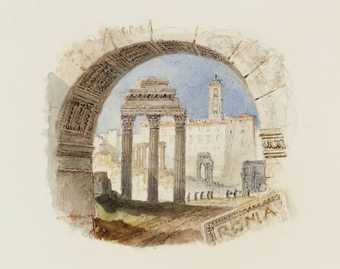
Joseph Mallord William Turner, The Forum, for Rogers’s ‘Italy’ ³¦.1826–7. Tate.
Experiments on Paper Vignettes by JMW Turner
9 rooms in JMW Turner
This room presents a selection of Turner’s ‘vignettes’, small watercolours made as illustrations for books
Between 1830 and 1839 Turner made over 150 of these small scenes. The word ‘vignette’ comes from the term ‘little vine’, a reference to decorative vine-like designs in books. By the 19th century, ‘vignette’ had come to mean an illustration that had no border or hard edges.
Turner’s vignettes were mostly made for books written by leading poets of his day, including Lord Byron and Sir Walter Scott. Publishers were guaranteed good sales if Turner’s name was on the cover of the book. For Turner, it was an opportunity to boost his fame and relevance. The illustrated books enabled thousands of people to encounter Turner’s work without travelling to an exhibition to see his paintings.
A lover of literature who also wrote his own poetry, Turner clearly enjoyed the challenge of illustrating texts. Although they are small, the vignettes show Turner’s creative and technical skills in full. He conjures the same dramatic effects seen in his large-scale oil paintings: moonlight, sunrise, storms, the haze of snow. He gives us elaborate compositions, presenting vast, expansive spaces in miniature. Turner used a tiny brush made of a single squirrel hair to paint the fine details, requiring immense skill and control.
Highly skilled engravers had the job of transforming these intricate watercolours into monochrome prints. They used sharp tools to cut Turner’s design into a steel plate, then applied ink to the plate to print the image onto paper. Turner closely supervised their work, directing them to make changes so that their prints more closely matched his original vision.
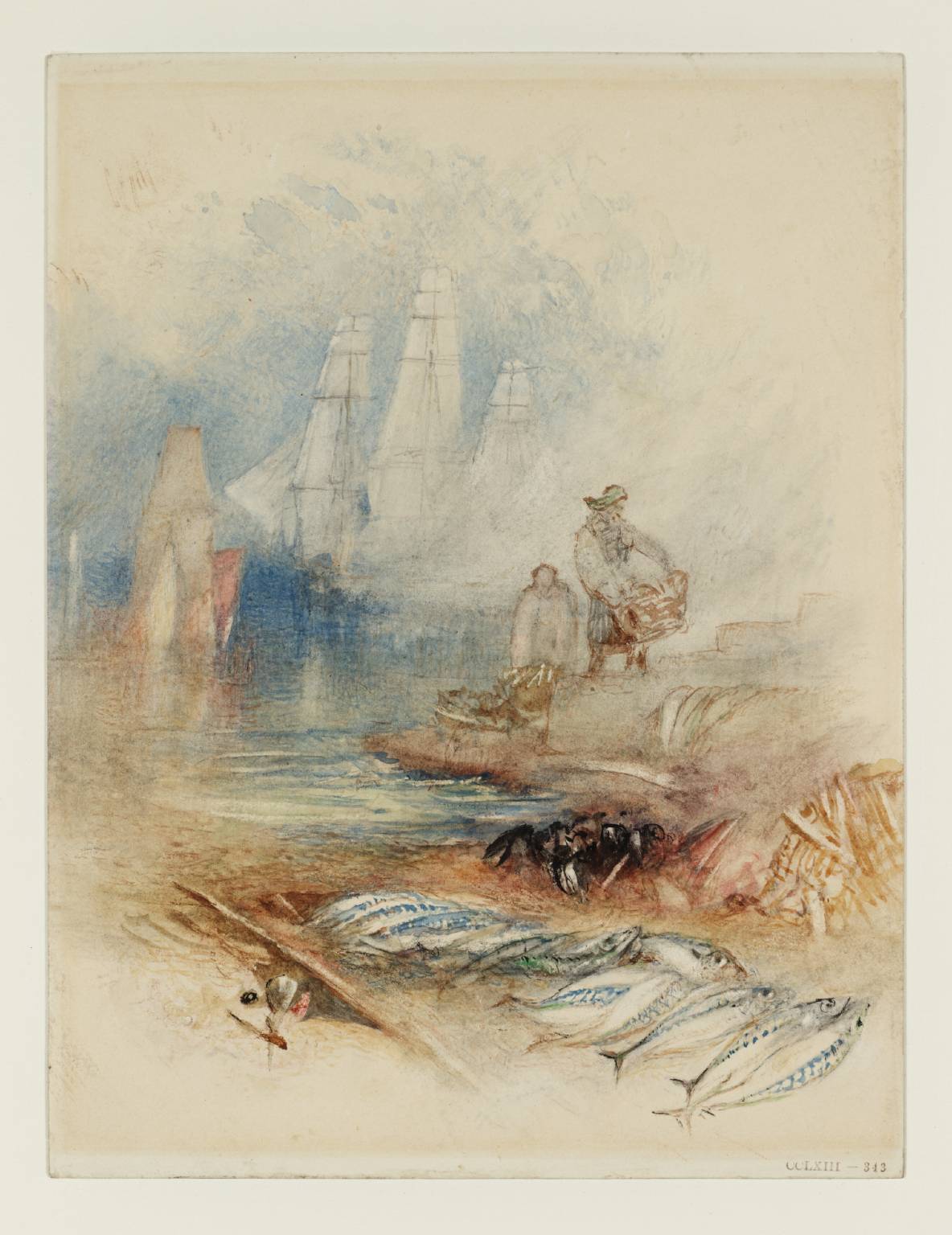
Joseph Mallord William Turner, Study for Unidentified Vignettes: Mackerel on a Beach c.1835
1/30
artworks in Experiments on Paper
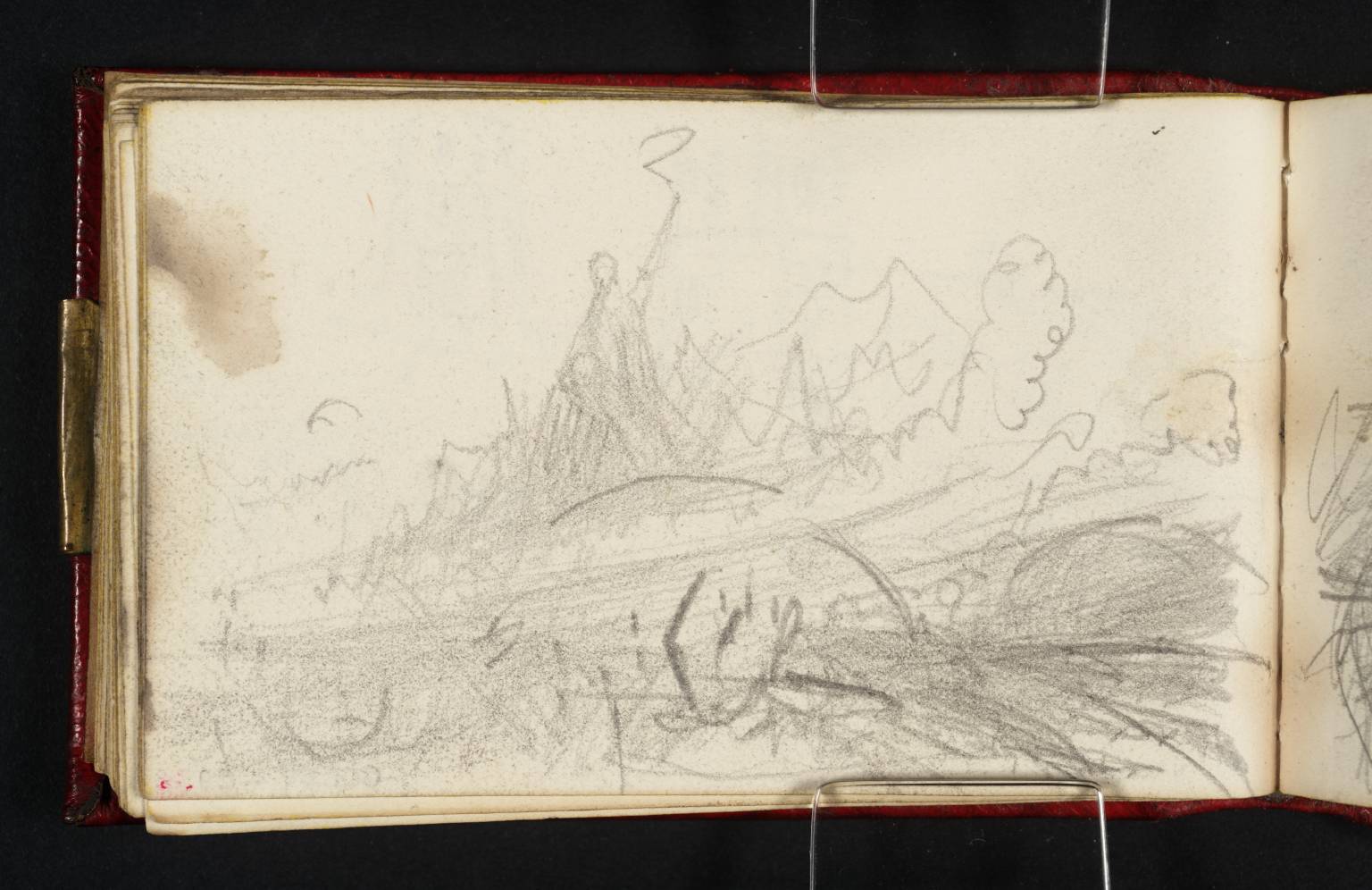
Joseph Mallord William Turner, Study for Vignette of A Tempest - Voyage of Columbus 1831
These energetic pencil sketches record Turner’s first thoughts on how to depict the moment in Rogers’s poem, ‘Voyage of Columbus’, in which an angel appears through a storm to warn of future war. Turner captures his vision for the scene using a flurry of hurried pencil marks. This sketchbook is named after Turner’s journey through Berwick-upon-Tweed, a town on the border of England and Scotland, in 1831. Turner was in Scotland to collect material for another illustration project.
Gallery label, January 2025
2/30
artworks in Experiments on Paper
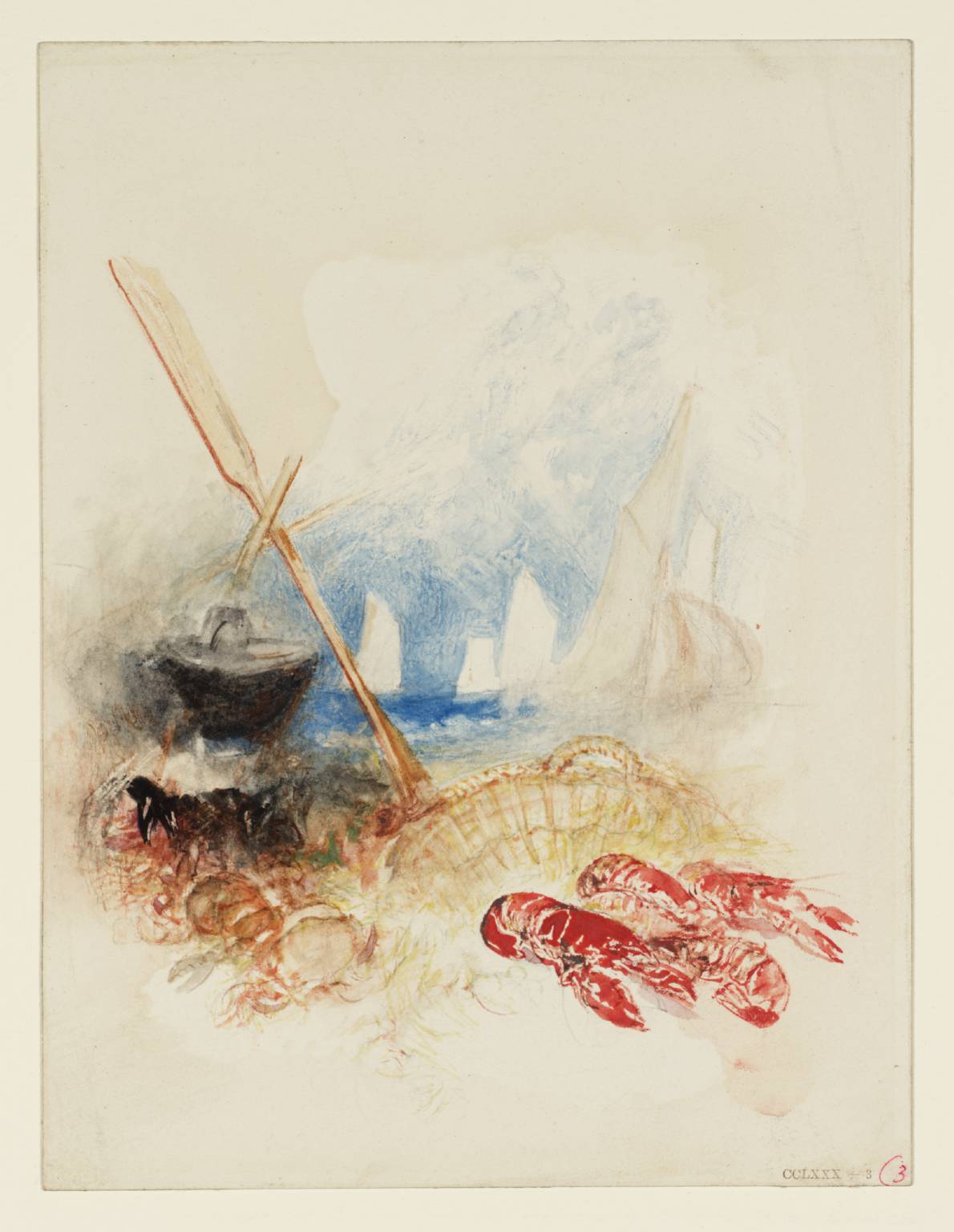
Joseph Mallord William Turner, Study for Unidentified Vignettes: Lobsters on the Beach c.1835
3/30
artworks in Experiments on Paper
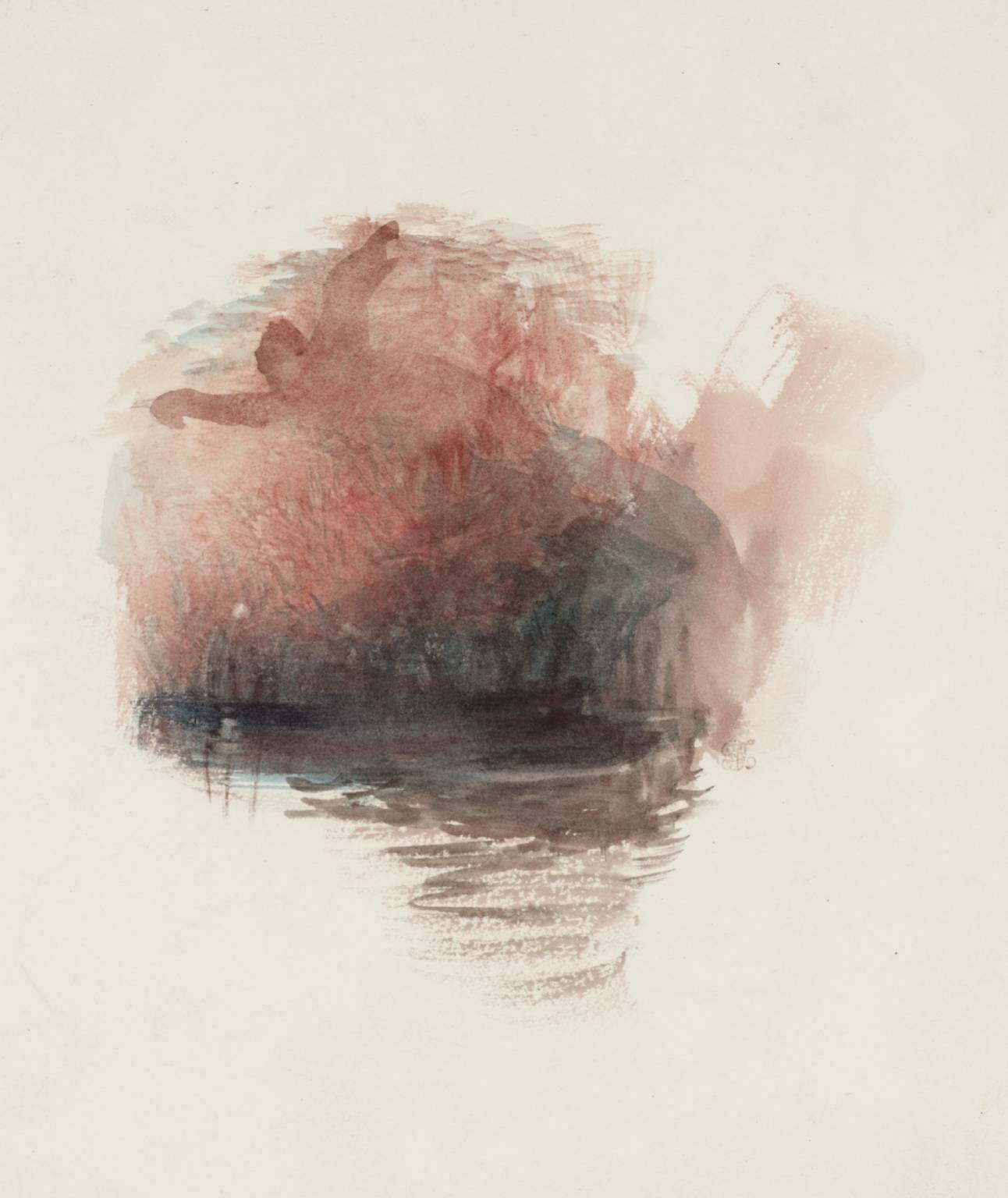
Joseph Mallord William Turner, Study for ‘A Tempest’, Rogers’s ‘Poems’ &²Ô²ú²õ±è;³¦.1830–2
‘The Voyage of Columbus’ was the final work in Rogers’s Poems. Turner produced seven illustrations for it. This is a sketch for the finished watercolour displayed nearby. The figure of the angel, warning Columbus of difficulties ahead, appears over Columbus’s ship and the moon. Rogers’s focus on Christopher Columbus’s transatlantic journey reflects a renewed interest in the Americas in late 18th-century Britain. This interest was triggered by the American Revolutionary War (1775–1783), which established the United States as independent of British colonial rule.
Gallery label, January 2025
4/30
artworks in Experiments on Paper
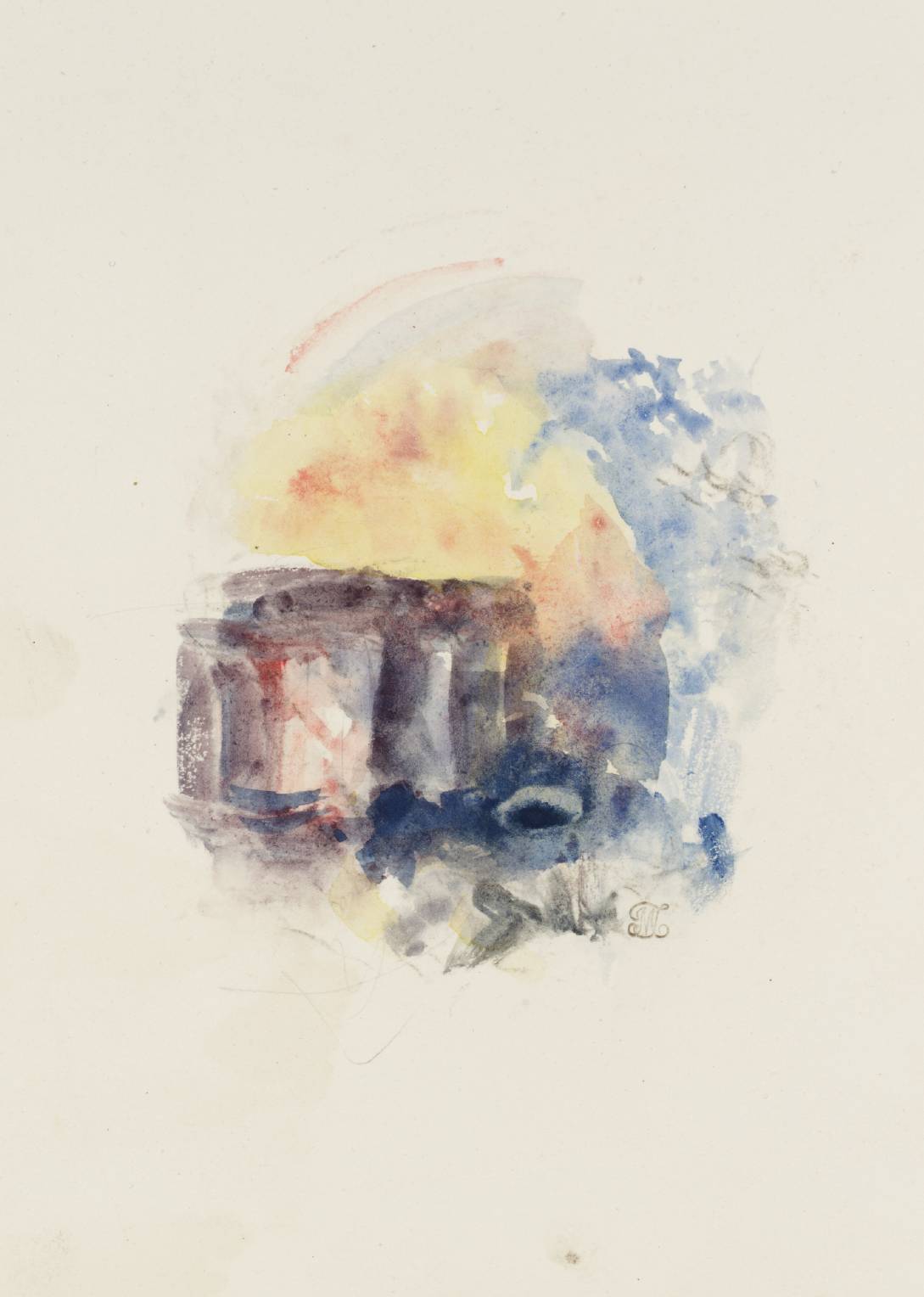
Joseph Mallord William Turner, Vignette Study of a Temple, with Rainbow, possibly for Moore’s ‘The Epicurean’ &²Ô²ú²õ±è;³¦.1835–8
5/30
artworks in Experiments on Paper
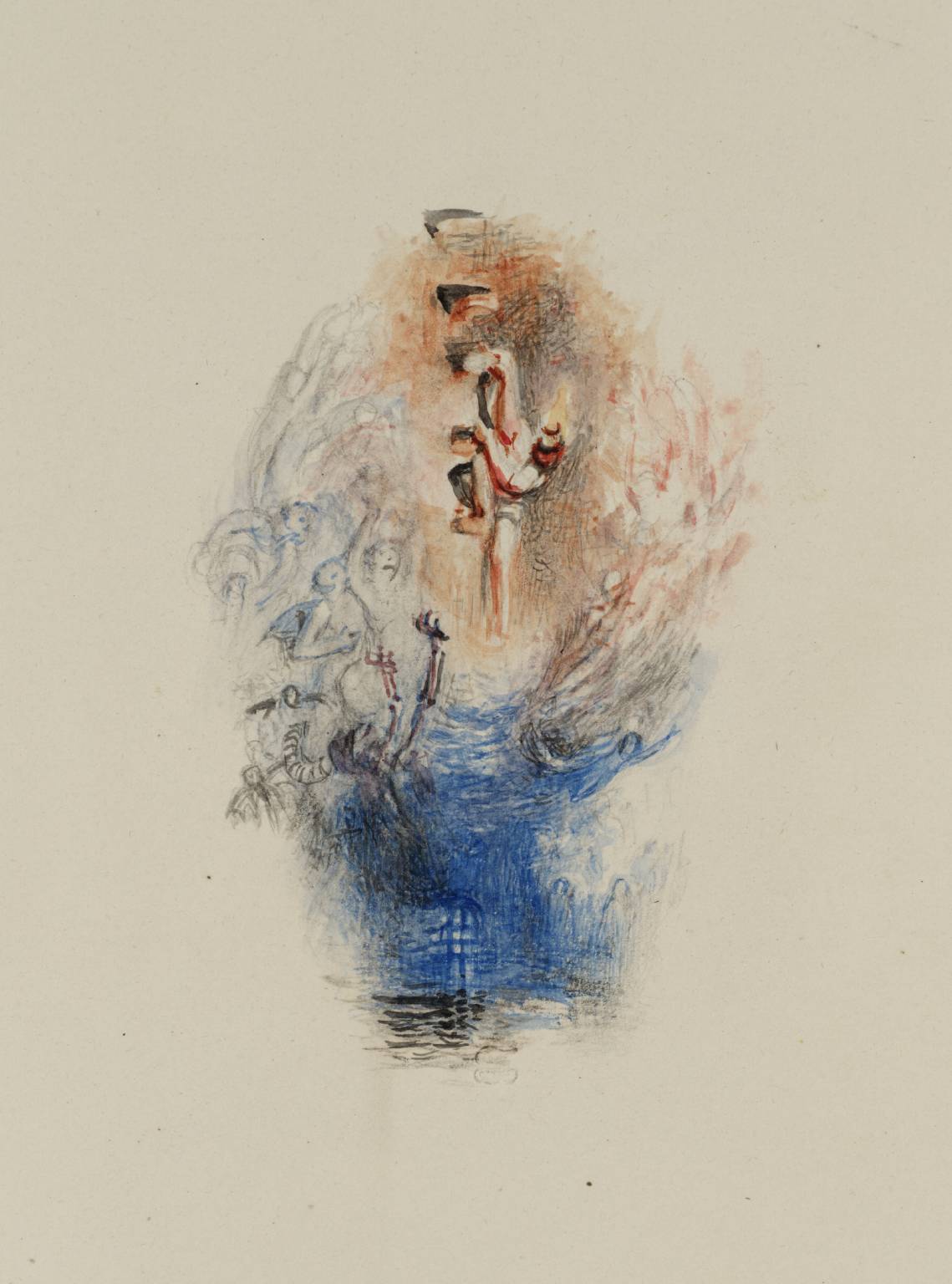
Joseph Mallord William Turner, Vignette Study for Moore’s ‘The Epicurean’; Descent into the Well &²Ô²ú²õ±è;³¦.1837–8
The figure at the centre of this scene is Alciphron, the main character of Moore’s poem, The Epicurean. Alciphron is seen nervously climbing down into a well beneath an Egyptian pyramid. He clings to the steps, looking down over his shoulder with one leg outstretched in search of his next foothold. As described in the poem, he has a torch strapped to his head. Alciphron is surrounded by skeletons and goblins – outlined in feathery strokes of watercolour. Turner used a fine brush made of a single squirrel hair to apply the paint in this way.
Gallery label, January 2025
6/30
artworks in Experiments on Paper
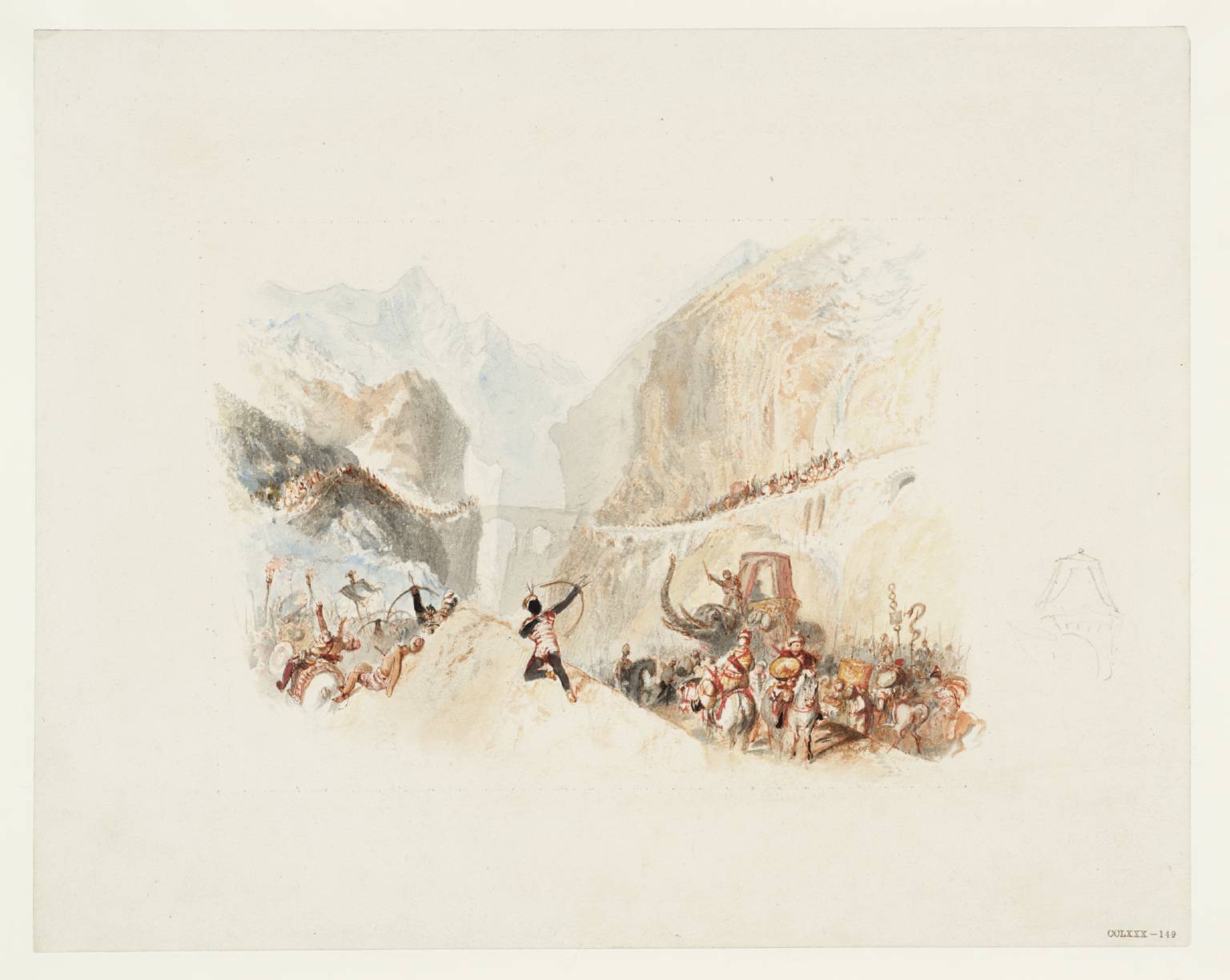
Joseph Mallord William Turner, Hannibal Passing the Alps, for Rogers’s ‘Italy’ &²Ô²ú²õ±è;³¦.1826–7
This watercolour illustrates lines of poetry about the Alps from Rogers’s Italy. The poet imagines the noise and chaos the mountains witnessed when, in 218BCE, the Carthaginian army – including elephants – marched through the Alps on their way to invade Italy. Carthage, a great rival to Rome, was an ancient city in what is now Tunisia, north Africa. The representation of a range of skin tones here is reflective of the various ethnicities that made up the Carthaginian army. This vignette composition went through several stages of refinement before Turner was satisfied. A pencil sketch of the elephant’s carriage can be seen to the right of the watercolour.
Gallery label, January 2025
7/30
artworks in Experiments on Paper
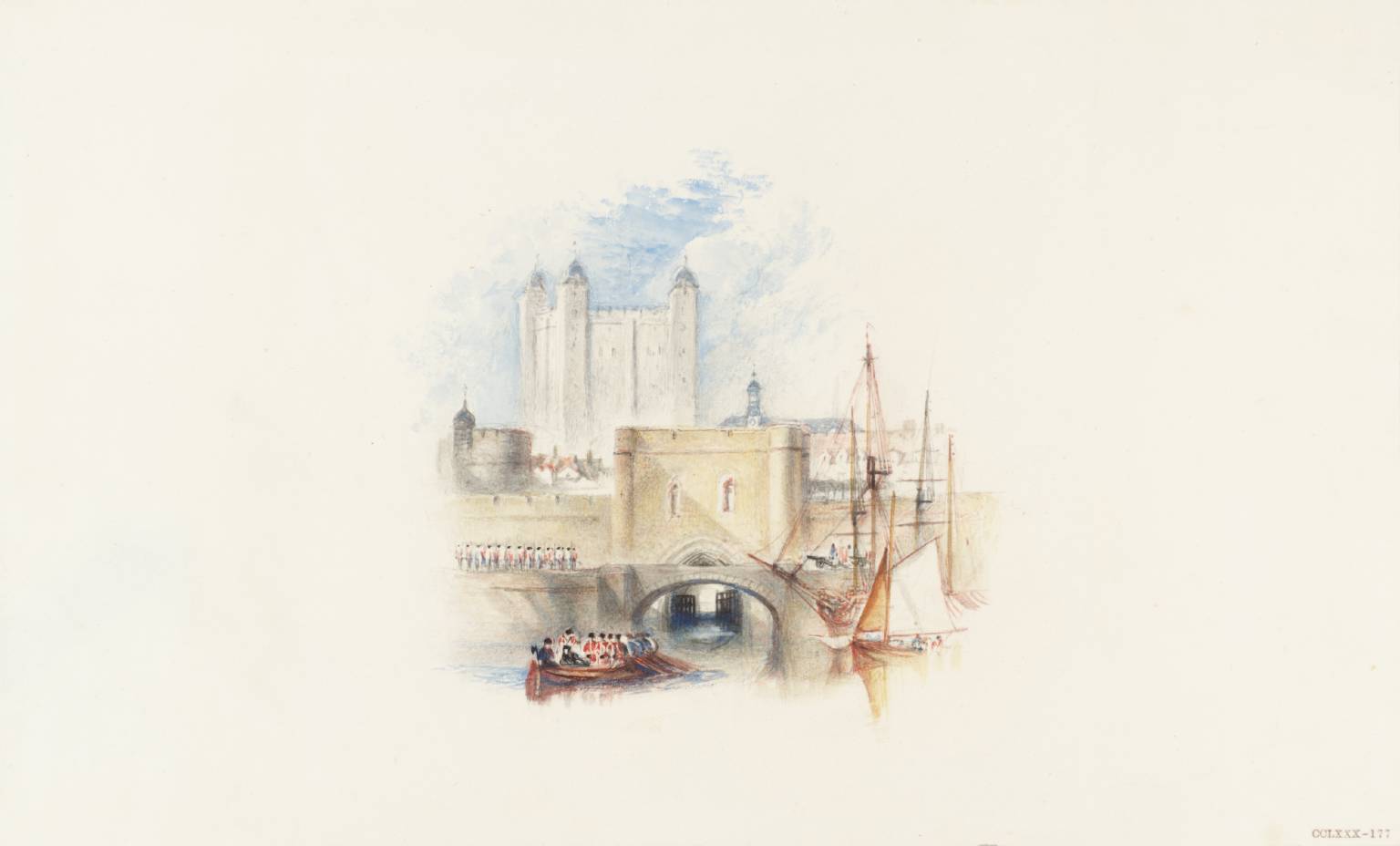
Joseph Mallord William Turner, Traitor’s Gate, Tower of London, for Rogers’s ‘Poems’ &²Ô²ú²õ±è;³¦.1830–2
In this image we see soldiers in 1790s uniform guarding passengers in costumes from the 1500s. This juxtaposition was deliberate. In the 1790s the British government suppressed civil rights in response to the French Revolution. The poem Turner was illustrating, ‘Human Life’, compared the 1790s to the 1500s and the experience of Thomas More, who was branded a traitor for refusing to accept King Henry VIII as head of the church. More appears in the boat, dressed in black. Turner did not paint these figures himself. They are the work of Thomas Stothard, who provided other illustrations for Rogers’s Poems.
Gallery label, January 2025
8/30
artworks in Experiments on Paper
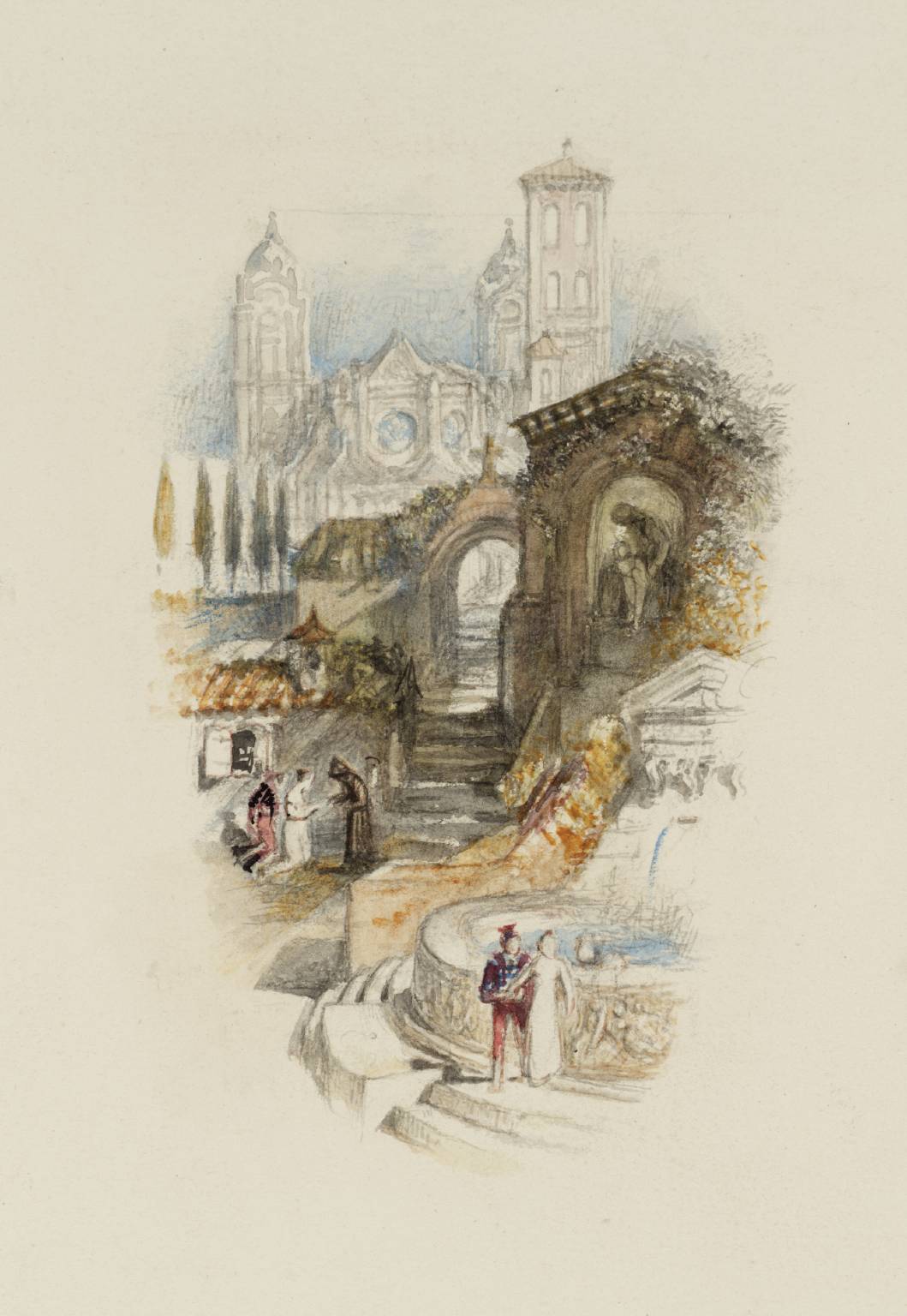
Joseph Mallord William Turner, St Julienne’s Chapel, for Rogers’s ‘Poems’ &²Ô²ú²õ±è;³¦.1830–2
9/30
artworks in Experiments on Paper
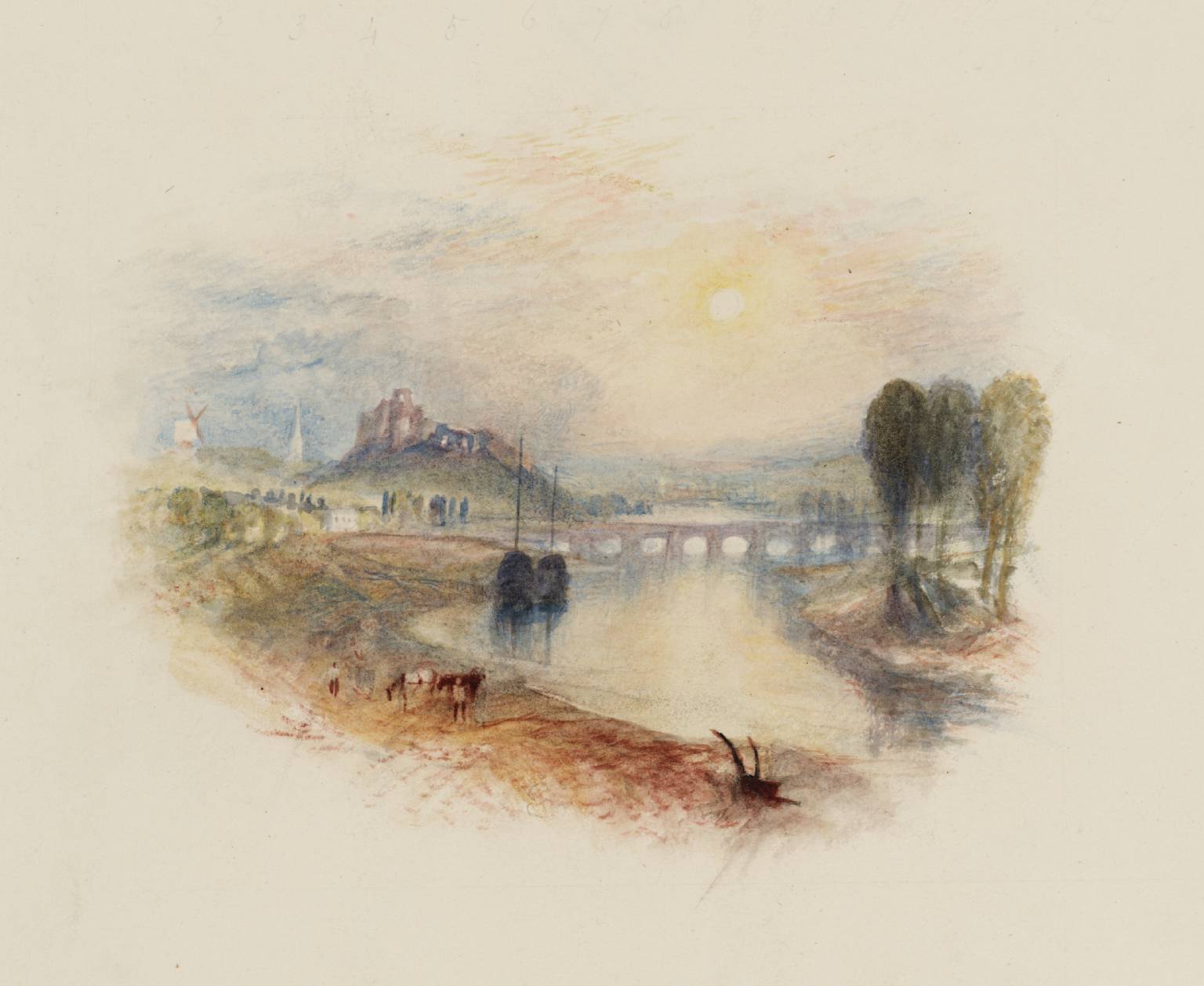
Joseph Mallord William Turner, Evening (Datur Hora Quieti), for Rogers’s ‘Poems’ &²Ô²ú²õ±è;³¦.1830–2
The Latin phrase in this watercolour’s title means ‘an hour given to quiet’. Turner painted it to appear at the end of Rogers’s Poems, a book which aimed to give readers an escape from their busy lives. The image draws on one of Turner’s favourite sources of inspiration, landscapes by 17th century French painter, Claude Lorrain. By studying his work, Turner learned how to create a pleasing path for our eye – from a field being ploughed in the foreground, we follow a meandering river, framed by a towering ruin and a line of trees, to distant rolling hills.
Gallery label, January 2025
10/30
artworks in Experiments on Paper

Joseph Mallord William Turner, A Village-Fair, for Rogers’s ‘Poems’ &²Ô²ú²õ±è;³¦.1830–2
11/30
artworks in Experiments on Paper
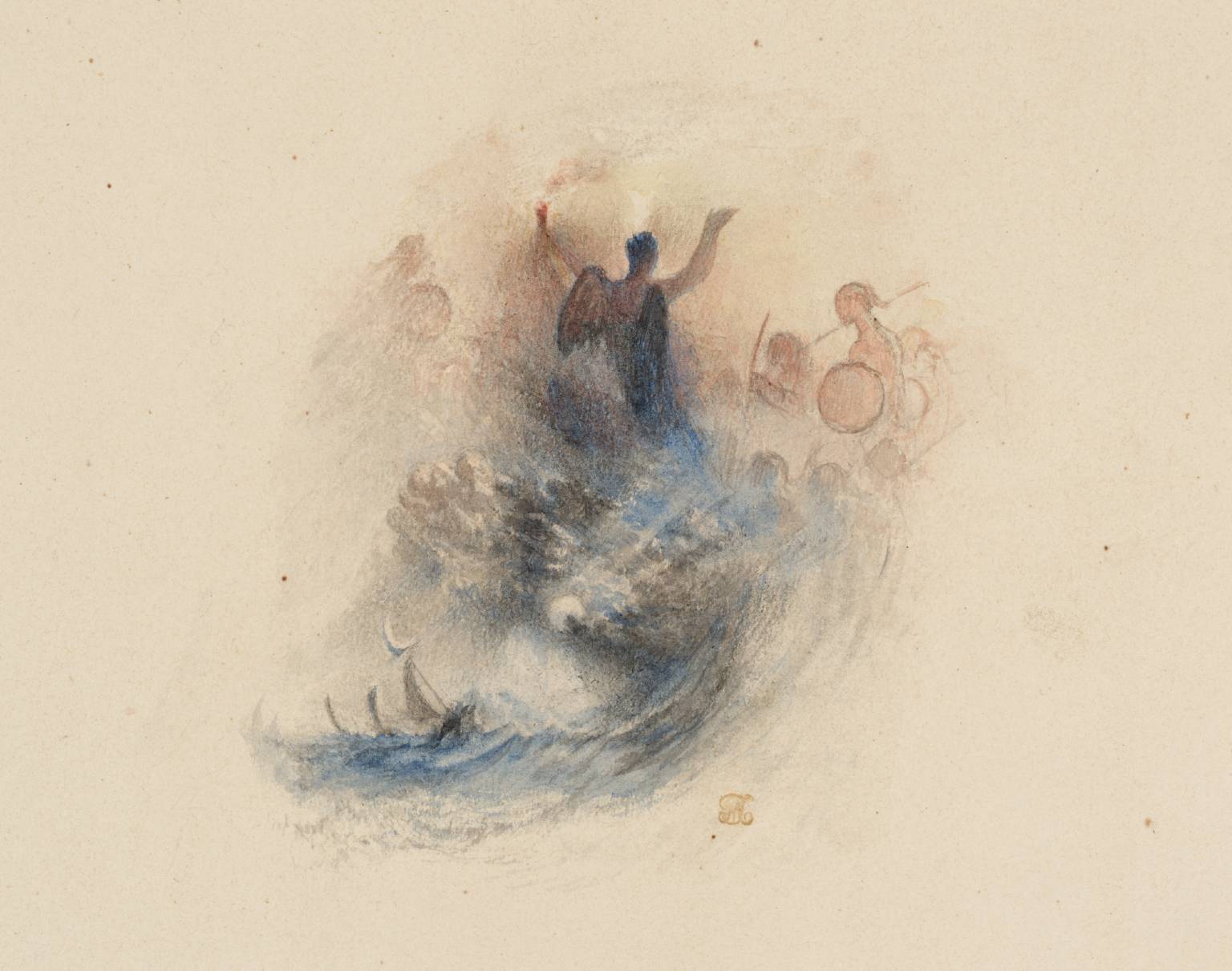
Joseph Mallord William Turner, A Tempest - Voyage of Columbus, for Rogers’s ‘Poems’ &²Ô²ú²õ±è;³¦.1830–2
This watercolour is Turner’s final composition for The Tempest. It builds on the pencil drawing in his sketchbook and the red-toned watercolour study displayed nearby. Depicting an angel surrounded by armed figures above the clouds, it specifically illustrates the threat described in Rogers’s poem: ‘in a night of clouds, thy Foes prepare To rock the globe with elemental wars’.
Gallery label, January 2025
12/30
artworks in Experiments on Paper
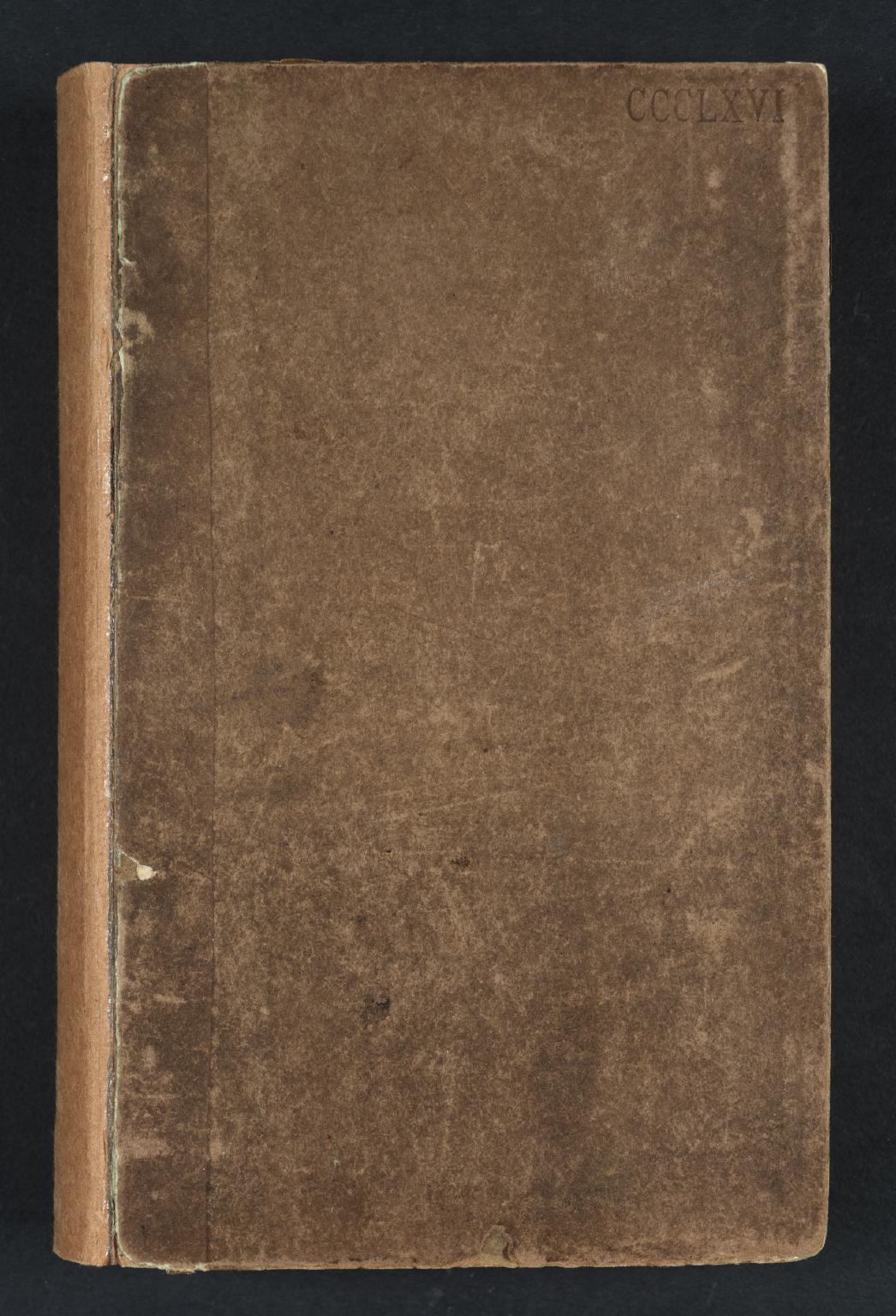
Joseph Mallord William Turner, Sketches and Inscriptions in a Copy of Rogers’s ‘Poems’ &²Ô²ú²õ±è;³¦.1830–2
Turner used this copy of Rogers’s Poems to plan the illustrations he was asked to create for a new edition of the book, to be published in 1834. This page records Turner’s initial response to the poem, ‘The Boy of Egremond’. There are two thumbnail sketches and a pencil note referencing the alternative name – the Strid – for the poem’s setting. The sketch at the top of page 203 outlines the boy and his dog at the river crossing.
Gallery label, January 2025
13/30
artworks in Experiments on Paper
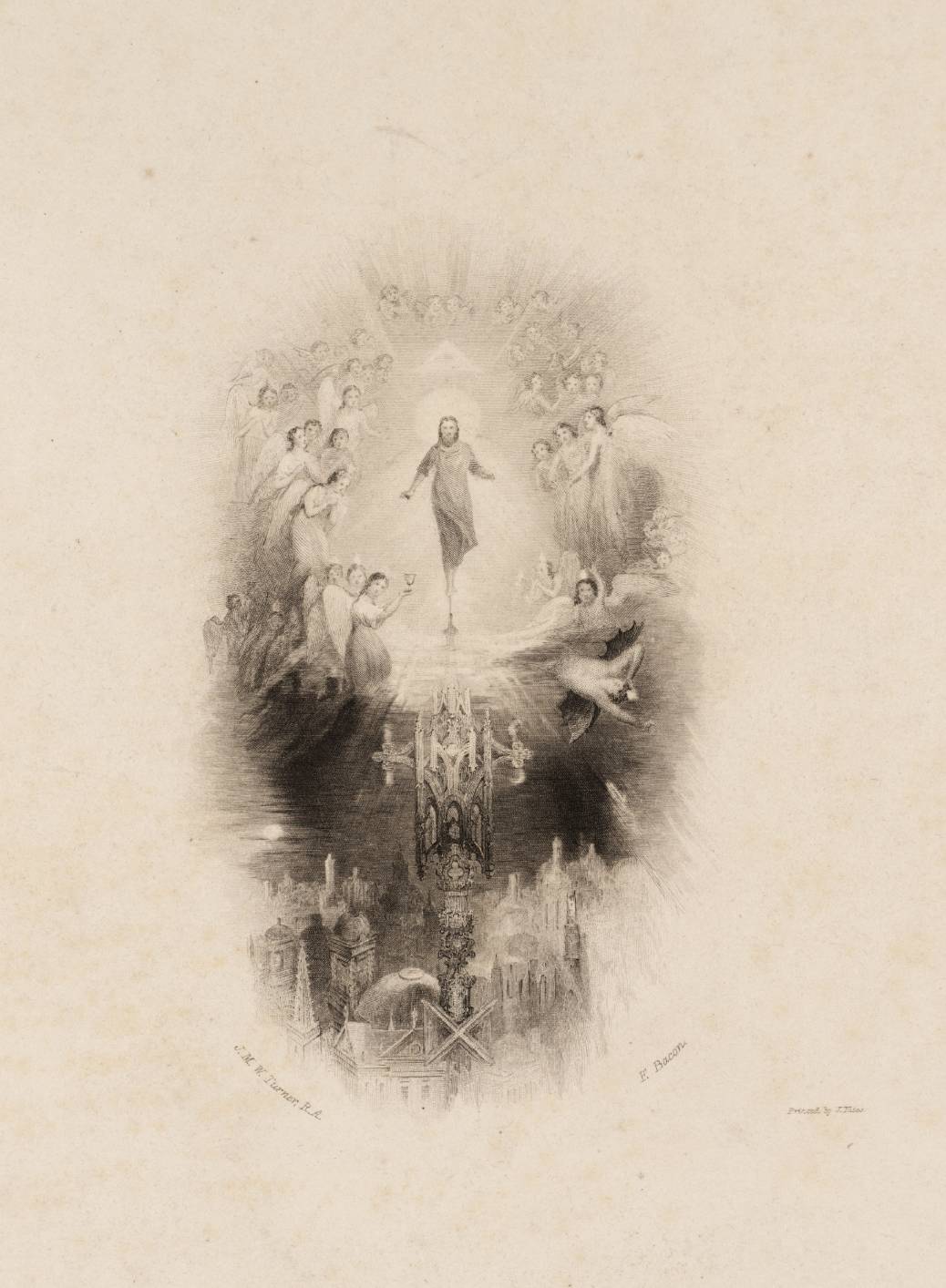
after Joseph Mallord William Turner, The Temptation on the Pinnacle, engraved by F. Bacon published 1835
Turner never relaxed his control over the engraving process. Frederick Bacon was the engraver tasked with the challenge of making this print after Turner’s watercolour. Bacon had been taught by Edward Finden, who had engraved several of Turner’s works. This would have reassured Turner that Bacon was skilled enough to take on this detailed, complex composition. This engraving was made using a steel plate. First used by engravers of bank notes in the 1800s, the hard surface of the metal helped engravers make the very fine lines needed to reproduce detail on this very small scale.
Gallery label, January 2025
14/30
artworks in Experiments on Paper
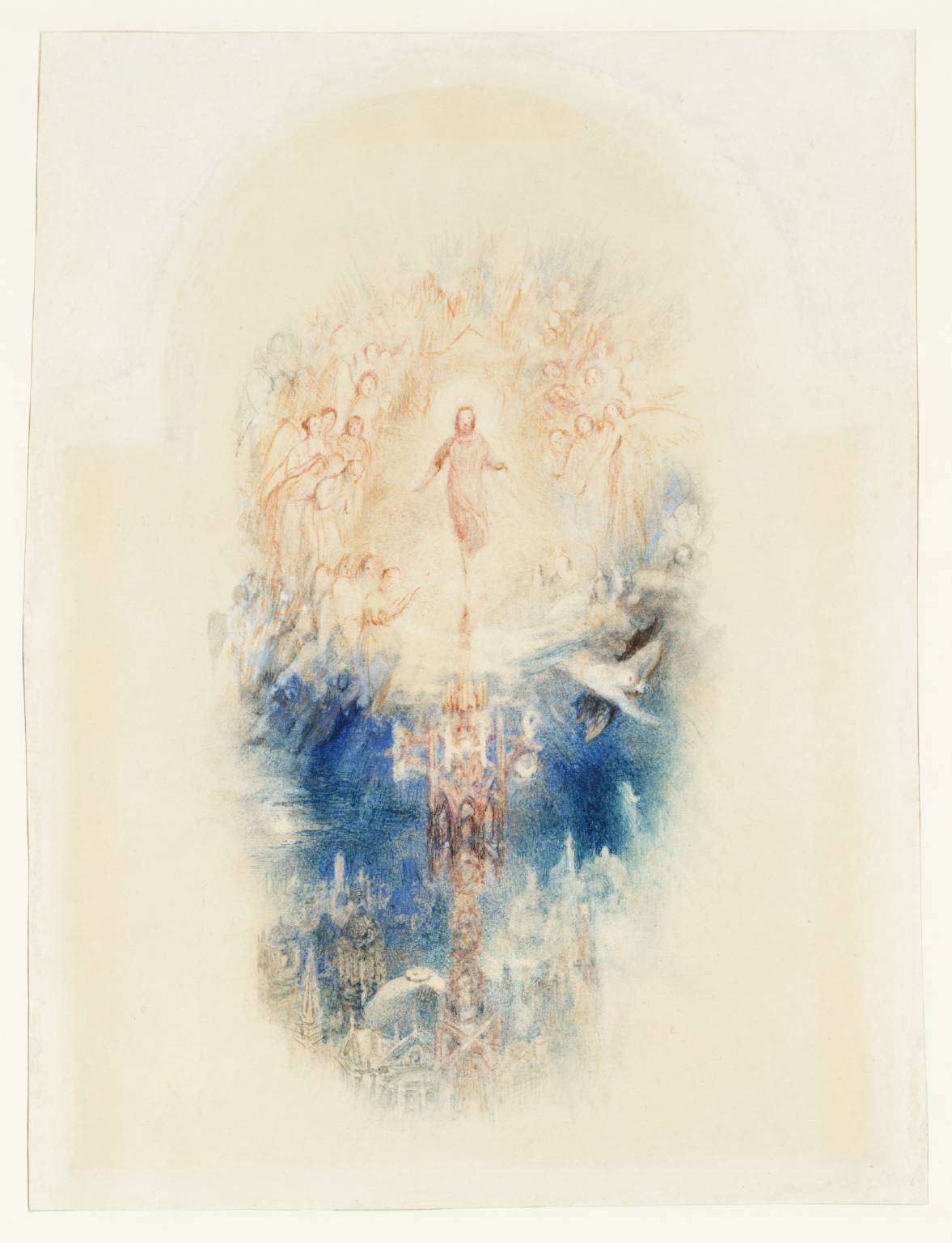
Joseph Mallord William Turner, The Temptation on the Pinnacle c.1834
This vignette illustrates lines from Milton’s Paradise Regained, a sequel to his most famous poem, Paradise Lost. Turner shows us the moment when Satan challenges Jesus to prove his divine powers by either throwing himself down or balancing upon the highest point of the Temple in Jerusalem. When Jesus triumphs, Satan falls – he is the figure with black wings at the right of the image. Turner’s love for imagining architectural scenery is evident in the roofscape beneath the figures.
Gallery label, January 2025
15/30
artworks in Experiments on Paper
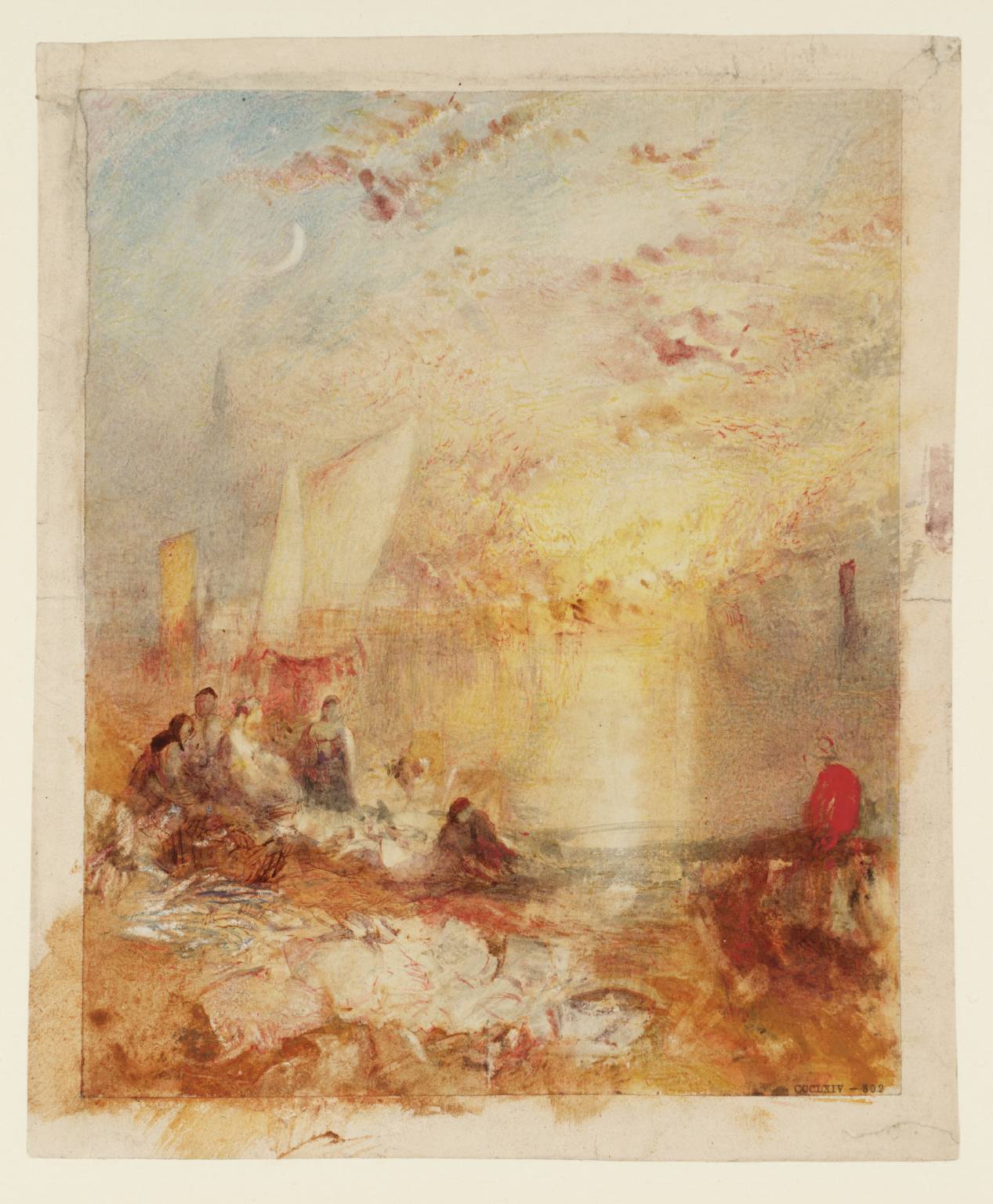
Joseph Mallord William Turner, Sunset: A Fish Market on the Beach c.1835
16/30
artworks in Experiments on Paper
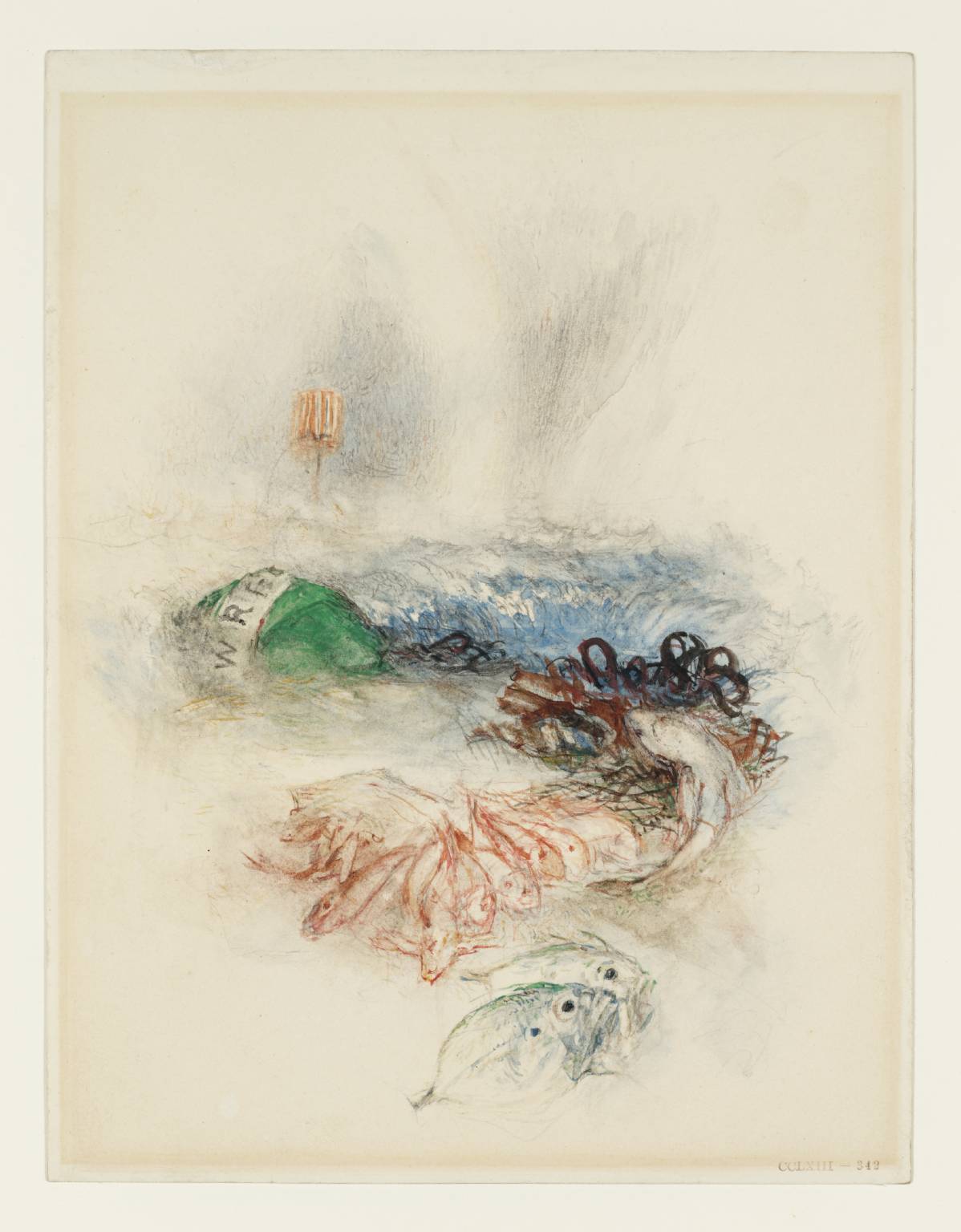
Joseph Mallord William Turner, Study for Unidentified Vignettes: Wreck Buoy, Gurnet, Dogfish, and Plaice c.1835
17/30
artworks in Experiments on Paper
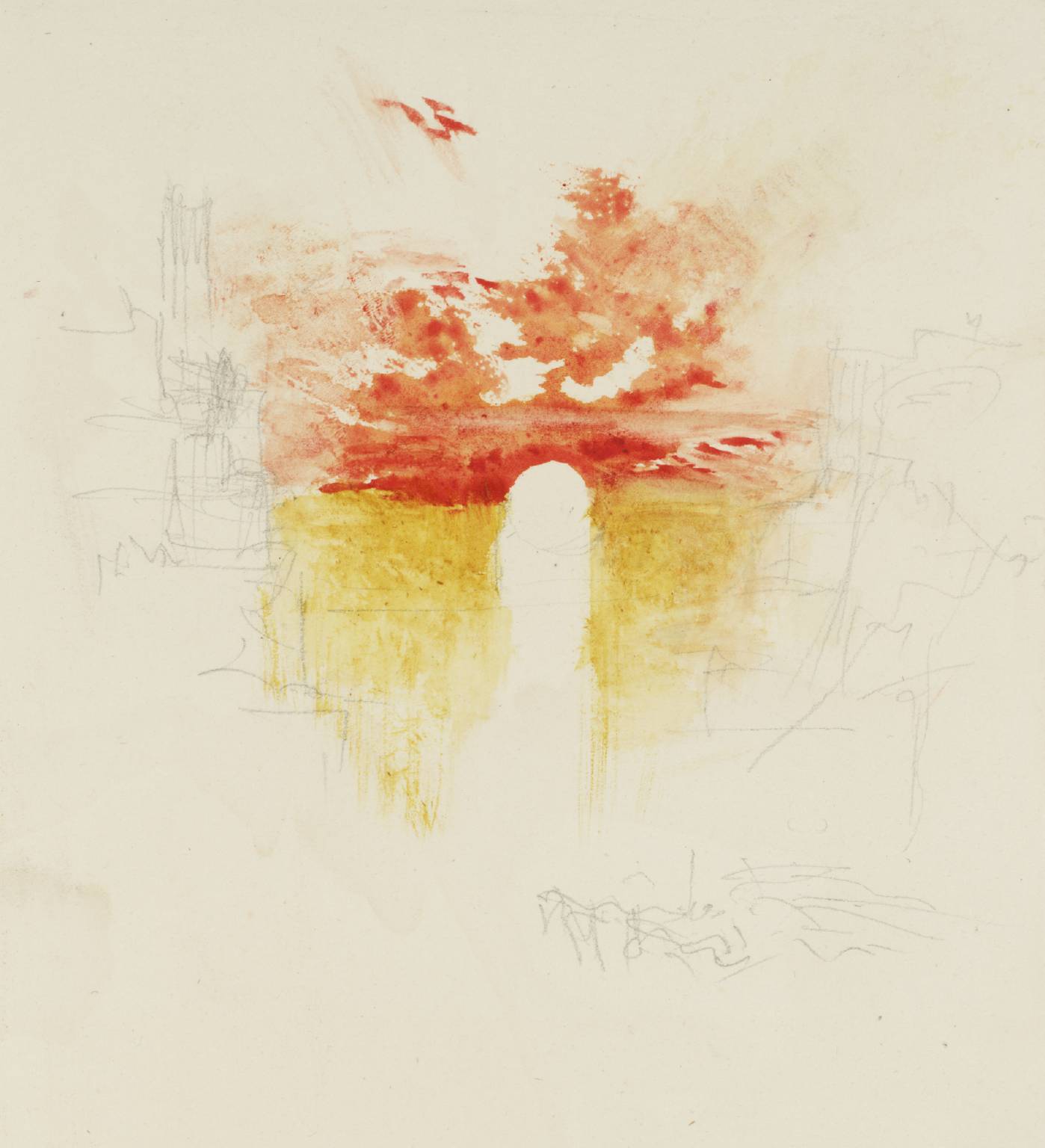
Joseph Mallord William Turner, Vignette Study for Moore’s ‘The Epicurean’; Sky for ‘The Nile’ &²Ô²ú²õ±è;³¦.1837–8
18/30
artworks in Experiments on Paper

Joseph Mallord William Turner, Vignette Study; Sea and Sun &²Ô²ú²õ±è;³¦.1826–36
Fluid, rapidly applied watercolour washes mark out different zones of colour and tone in this sketch. The white of the paper is retained to represent the sun and its reflection while a dark sweep of black on the left might represent a cliff face. Turner regularly worked in this way from the 1820s, mapping out the colours for compositions in broad, loose and watery sketches. Turner kept hold of thousands of sketches like this. This signals the importance he placed on preparatory work but also his tight control of what left his studio and entered the public domain.
Gallery label, January 2025
19/30
artworks in Experiments on Paper
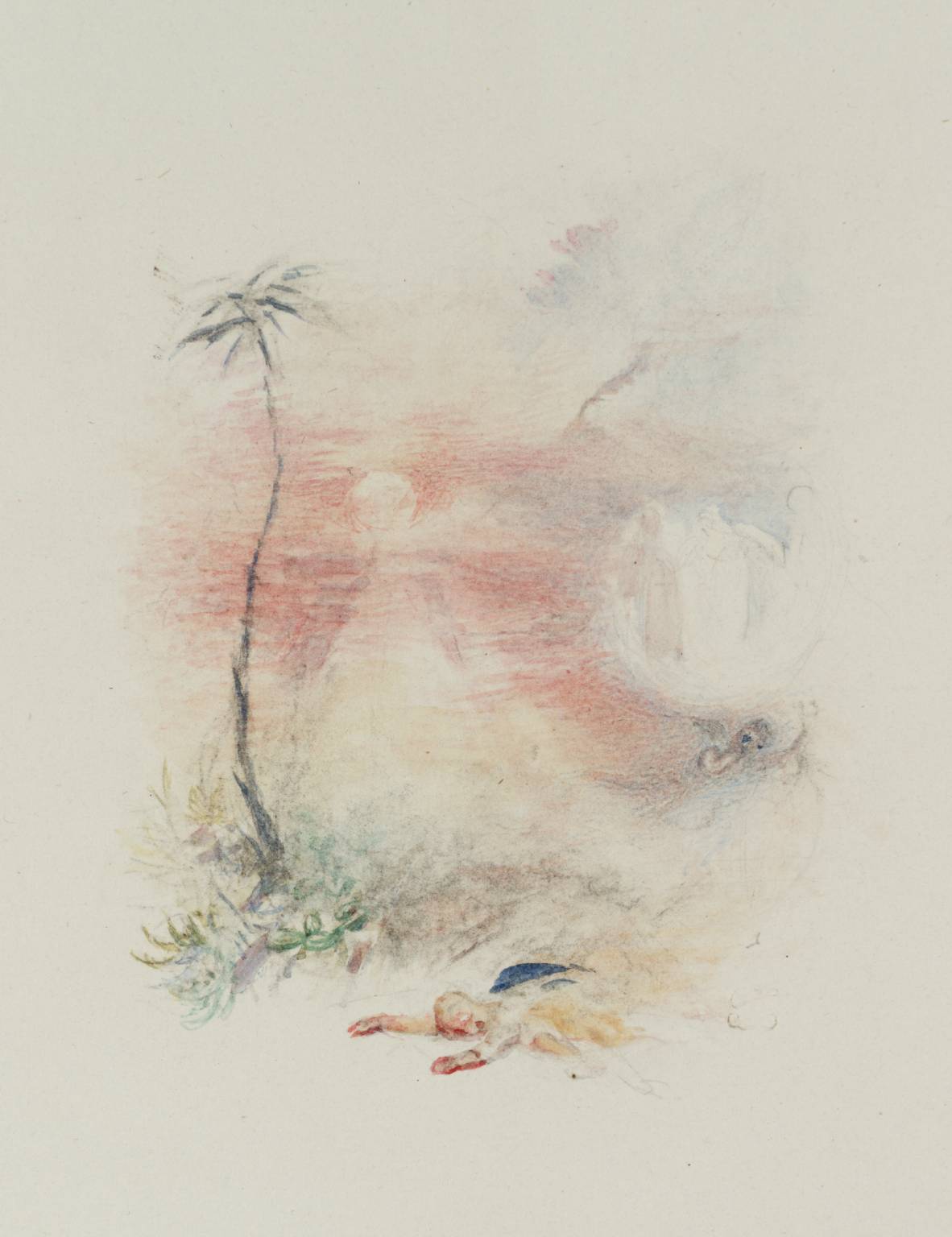
Joseph Mallord William Turner, Vignette Study for Moore’s ‘The Epicurean’; Alciphron’s Swoon c.1837
The main character in Moore’s poem, The Epicurean, is called Alciphron. This watercolour, which was not chosen to be engraved for publication, depicts one of several moments in which Alciphron falls into a deep sleep. Turner has taken lines spoken by the character as his inspiration: ‘Exhausted, I threw myself down at the base of the pyramid’, ‘the intense glow of sun over my head’. The white orb on the right–hand side may suggest Alciphron’s dream of Alethe, who is Priestess of the Moon in the poem.
Gallery label, January 2025
20/30
artworks in Experiments on Paper
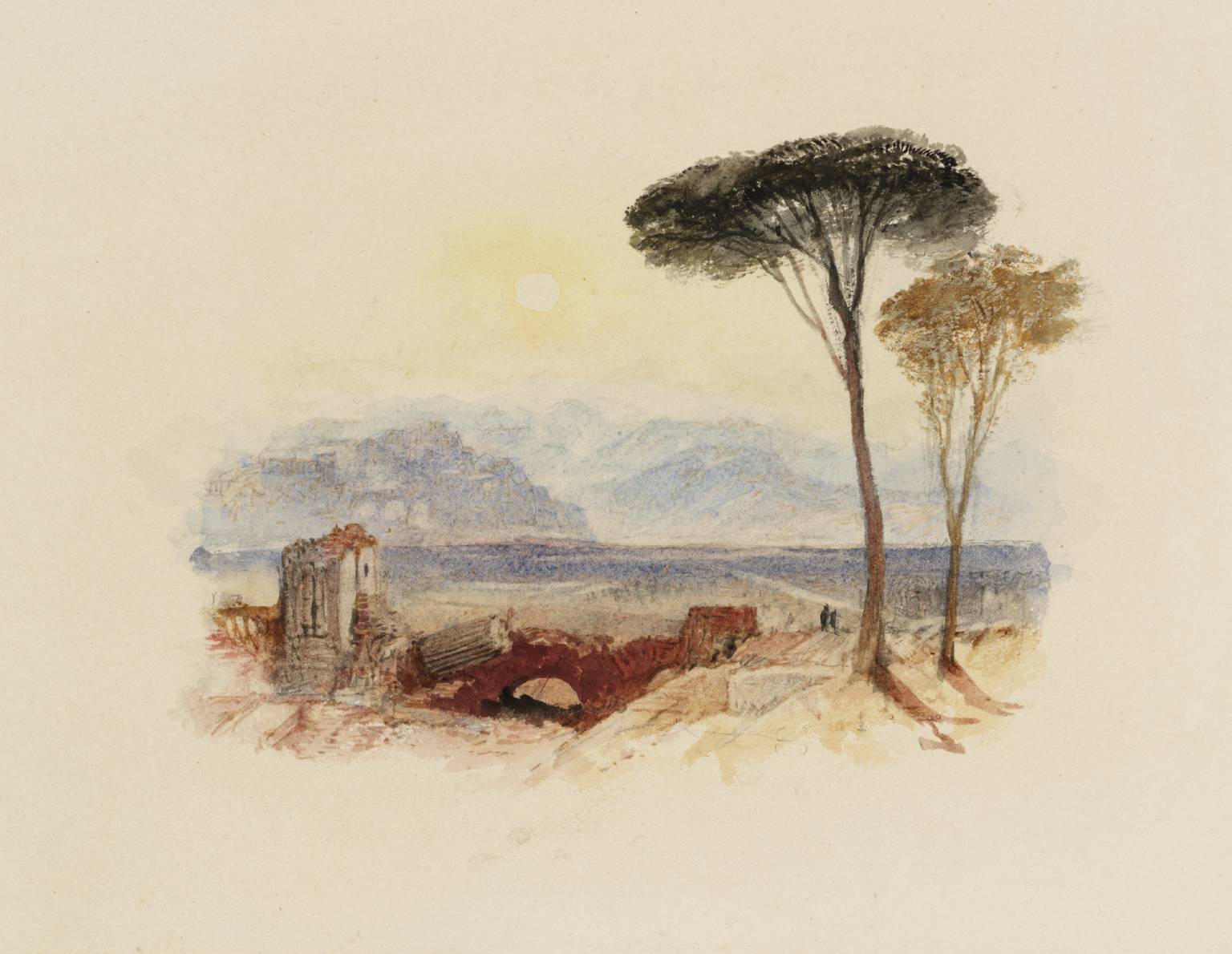
Joseph Mallord William Turner, Perugia, for Rogers’s ‘Italy’ &²Ô²ú²õ±è;³¦.1826–7
21/30
artworks in Experiments on Paper
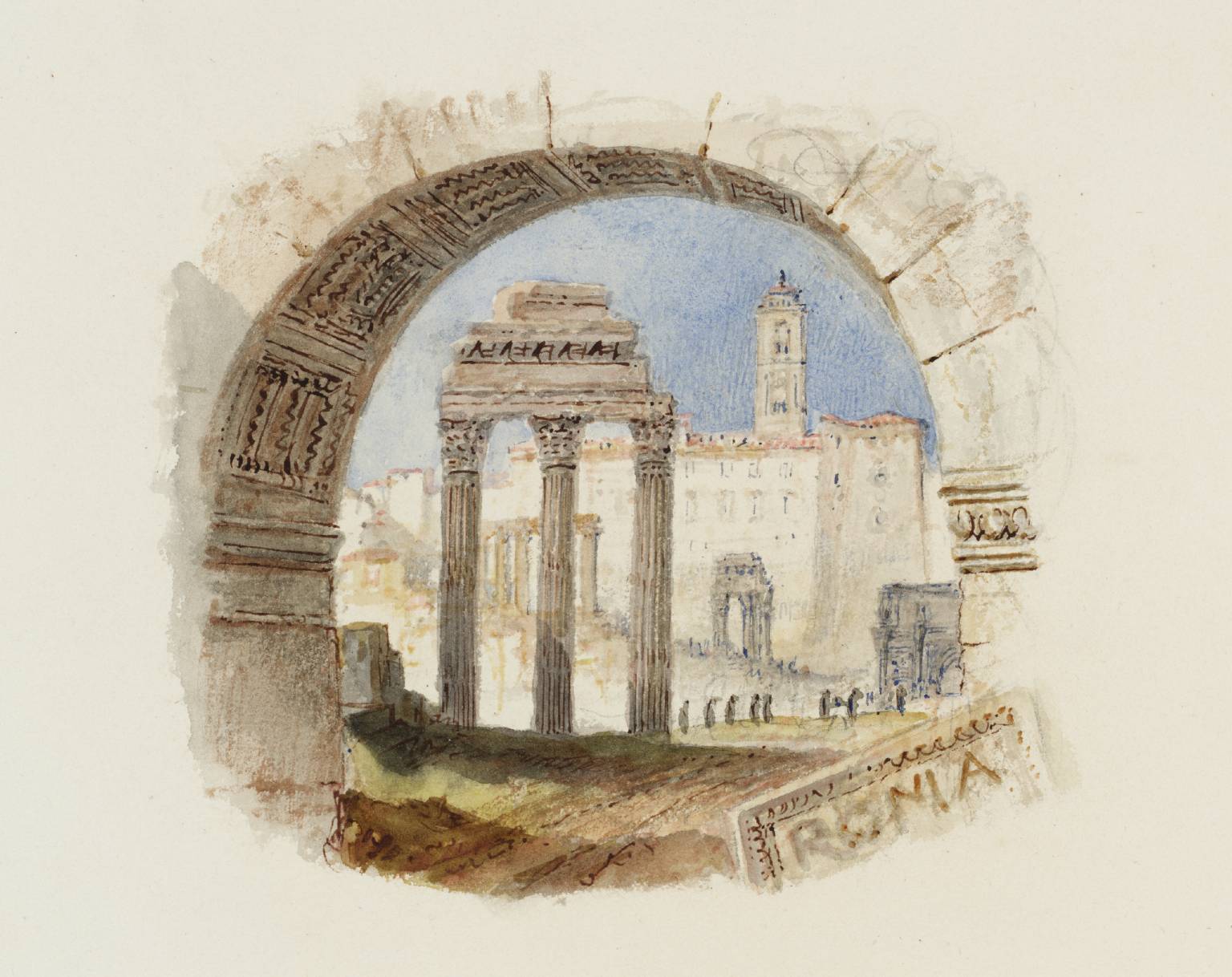
Joseph Mallord William Turner, The Forum, for Rogers’s ‘Italy’ &²Ô²ú²õ±è;³¦.1826–7
This innovative composition uses the Arch of Titus to frame our view across the ruins of the Roman Forum to the Capitoline Hill in the distance. Turner would have referred back to the many detailed sketches he made on his visit to the Forum in 1819. However, this precise view does not exist. Turner has rearranged the landmarks to include as many as possible. He also suggests that the ruins remain half–buried in soil when in fact they had been fully exposed.
Gallery label, January 2025
22/30
artworks in Experiments on Paper
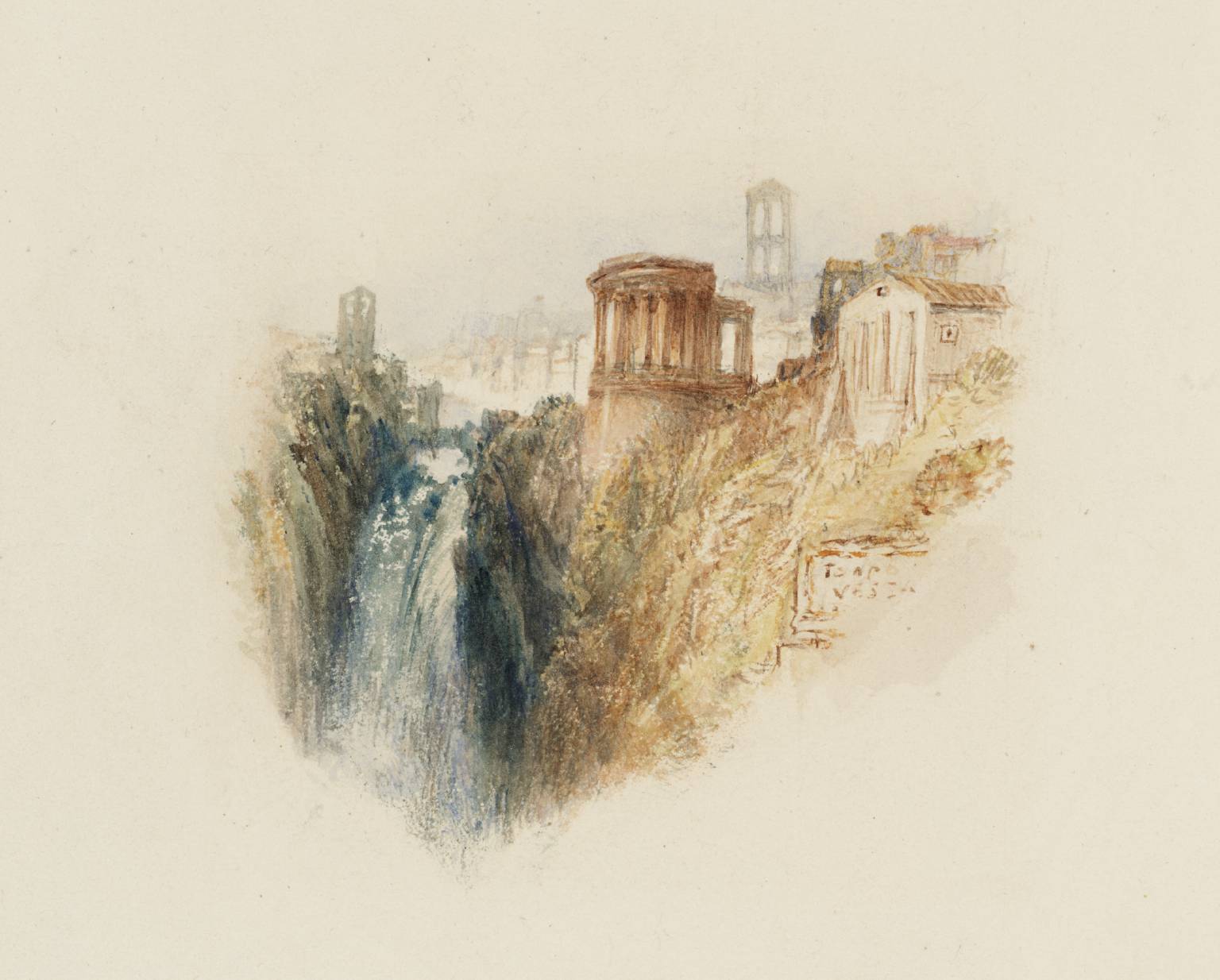
Joseph Mallord William Turner, Tivoli, for Rogers’s ‘Italy’ &²Ô²ú²õ±è;³¦.1826–7
23/30
artworks in Experiments on Paper
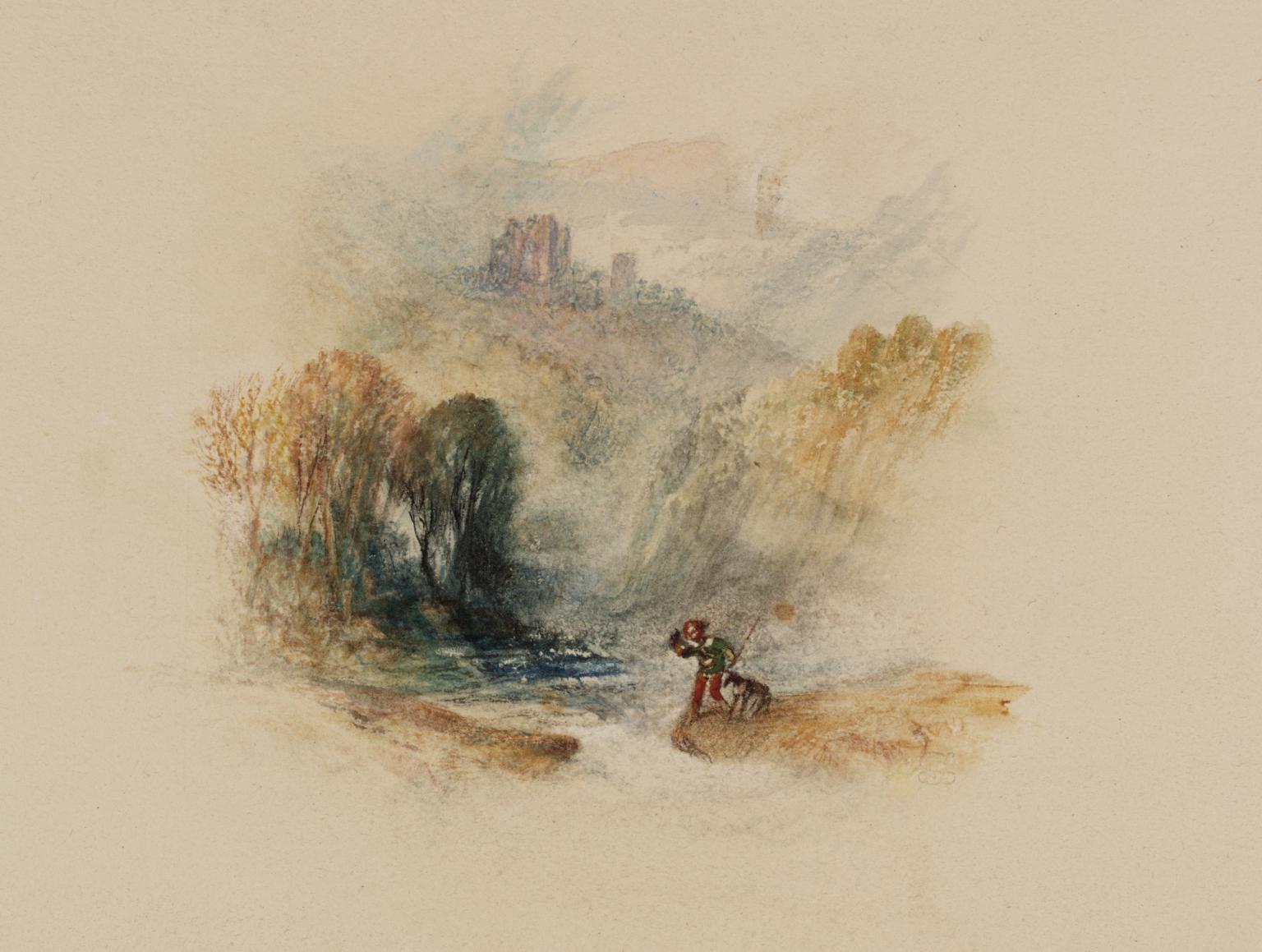
Joseph Mallord William Turner, The Boy of Egremond, for Rogers’s ‘Poems’ &²Ô²ú²õ±è;³¦.1830–2
‘The Boy of Egremond’ (or Egremont) tells the story of a boy who drowned crossing a fast stretch of Yorkshire’s River Wharfe in the 1100s. The tragedy had become a well-known folk story and was retold in the 1800s by Romantic poet William Wordsworth as well as Rogers. Turner shows the boy as described by Rogers, ‘With hound in leash and hawk in hood’. The backdrop is a dramatised blend of North Yorkshire landscape features plucked from Turner’s sketchbooks. His annotated copy of the poem can be seen in the display case nearby.
Gallery label, January 2025
24/30
artworks in Experiments on Paper
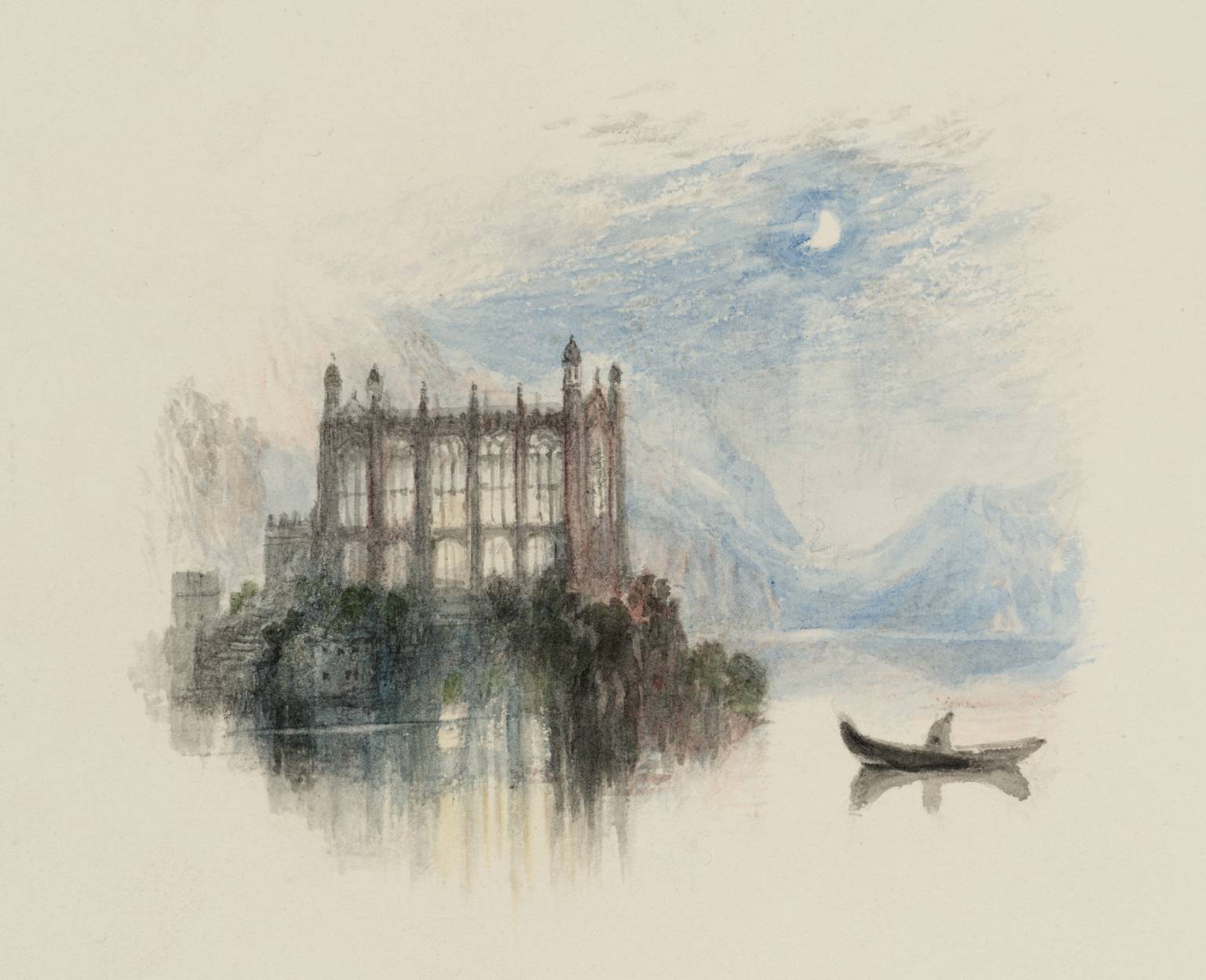
Joseph Mallord William Turner, St. Herbert’s Chapel, for Rogers’s ‘Poems’ &²Ô²ú²õ±è;³¦.1830–2
The setting here is the Lake District in the north west of England. St Herbert’s Isle, on Derwentwater, was named after the Christian saint who lived on it in the 7th century. The island features in Rogers’s most famous poem, ‘The Pleasures of Memory’. Rogers imagines the ruins of a chapel there, with a ‘mitred window, richly wreathed’ in foliage. However, Turner imagines a version of Eton College Chapel, situated in Windsor in the south of England. Rogers describes the mountains illuminated by the moon and how ‘evening tinged the lake’s ethereal blue’.
Gallery label, January 2025
25/30
artworks in Experiments on Paper
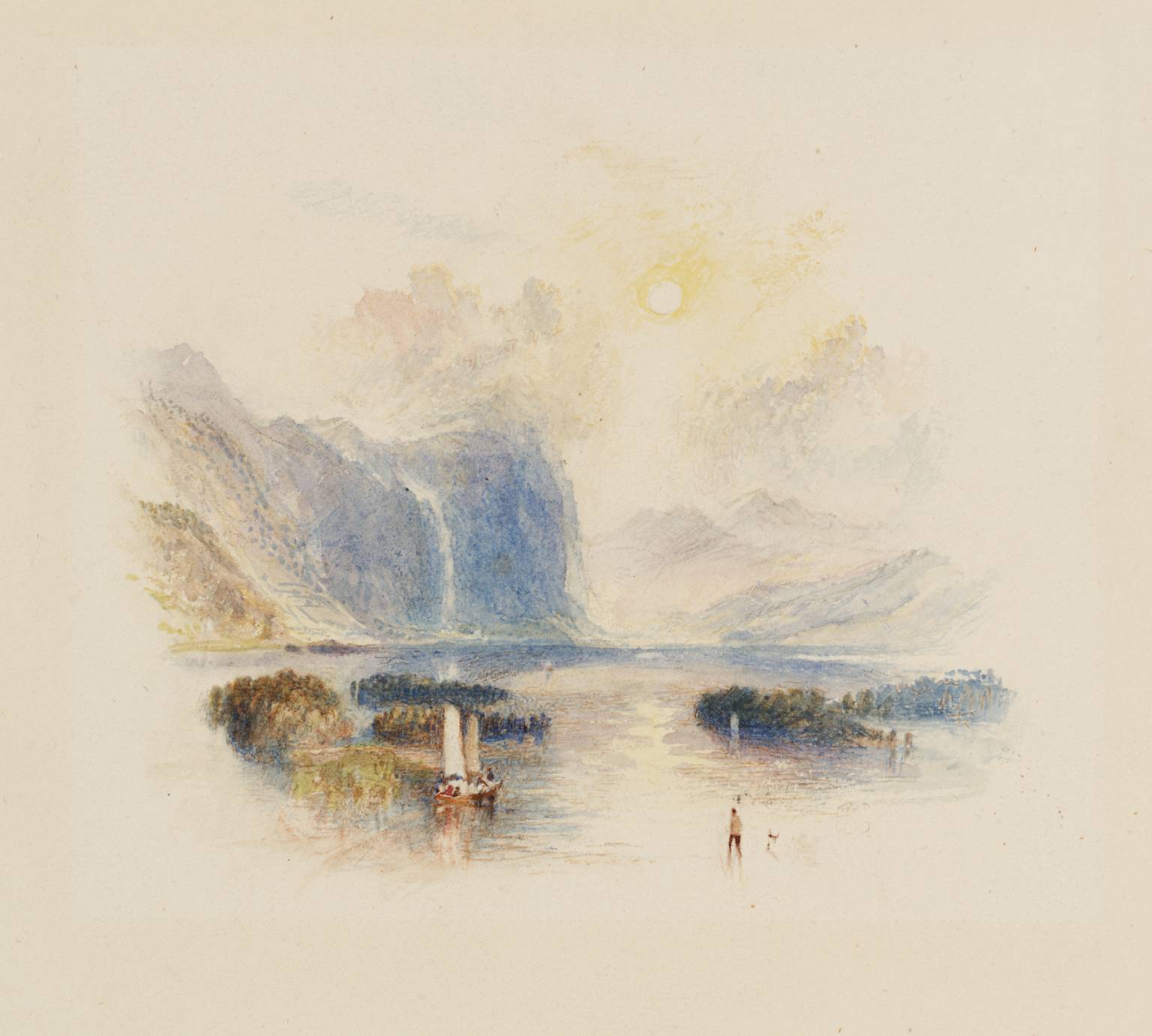
Joseph Mallord William Turner, Keswick Lake, for Rogers’s ‘Poems’ &²Ô²ú²õ±è;³¦.1830–2
26/30
artworks in Experiments on Paper
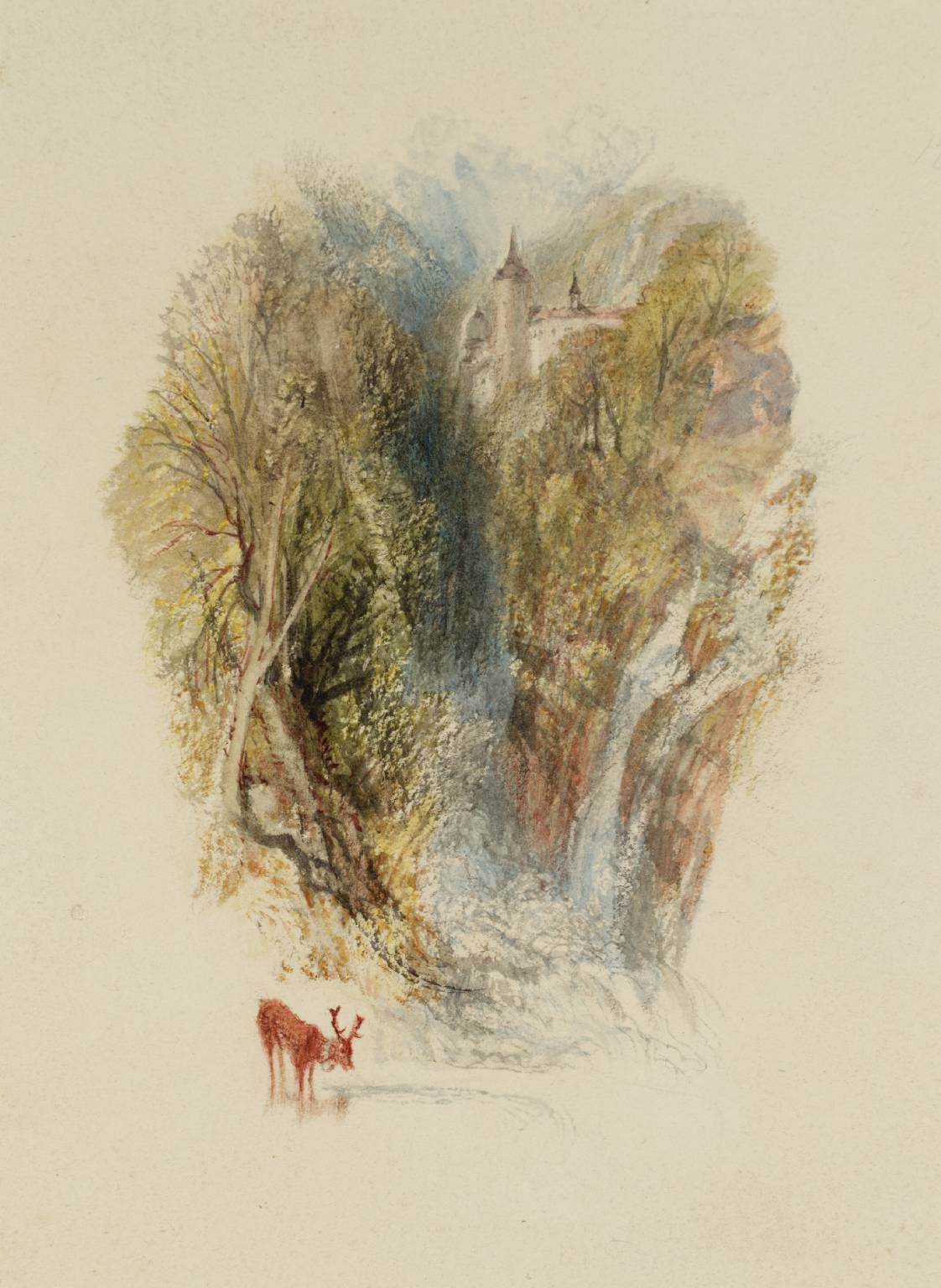
Joseph Mallord William Turner, Valombrè, for Rogers’s ‘Poems’ &²Ô²ú²õ±è;³¦.1830–2
27/30
artworks in Experiments on Paper
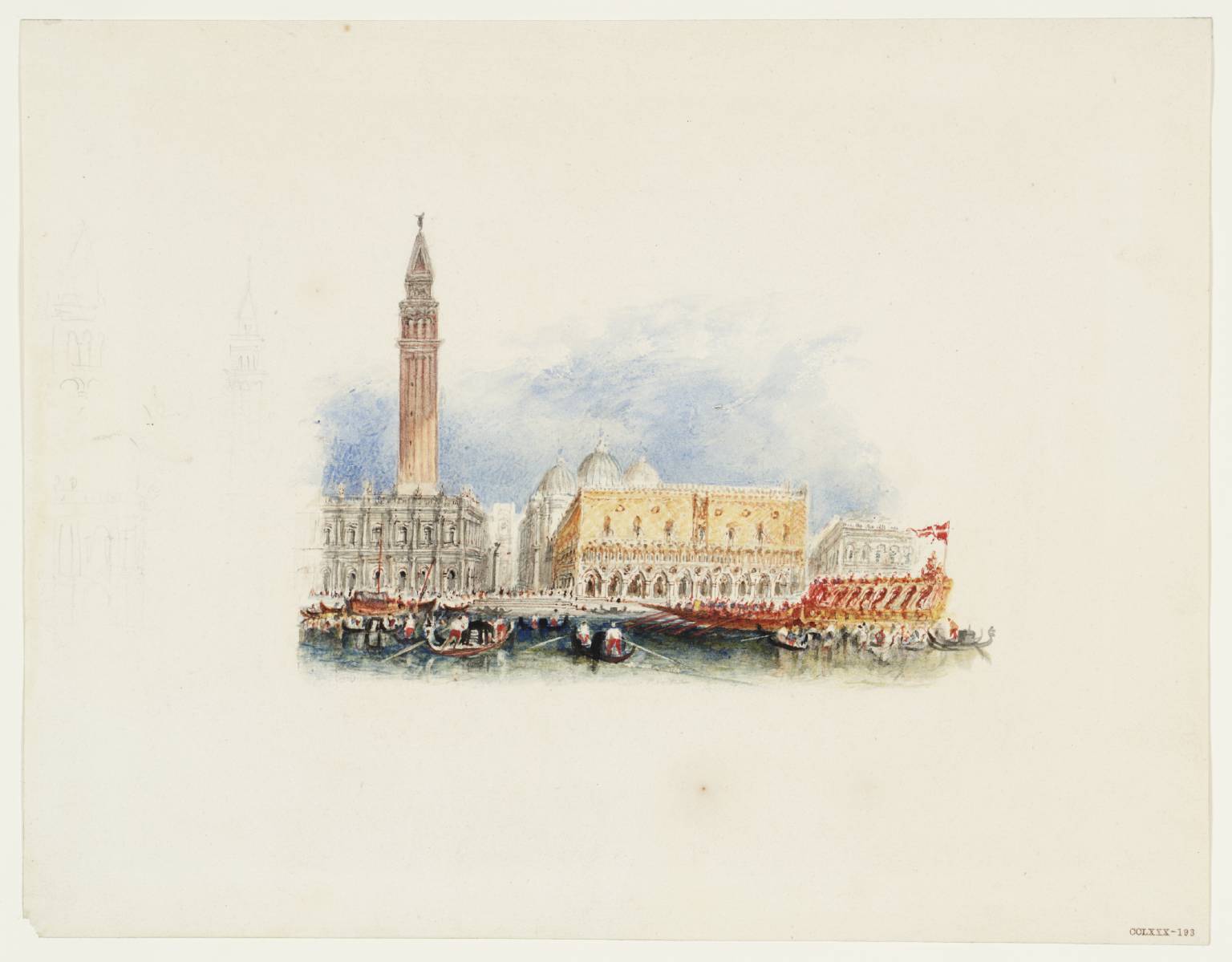
Joseph Mallord William Turner, Venice, for Rogers’s ‘Italy’ &²Ô²ú²õ±è;³¦.1826–7
28/30
artworks in Experiments on Paper
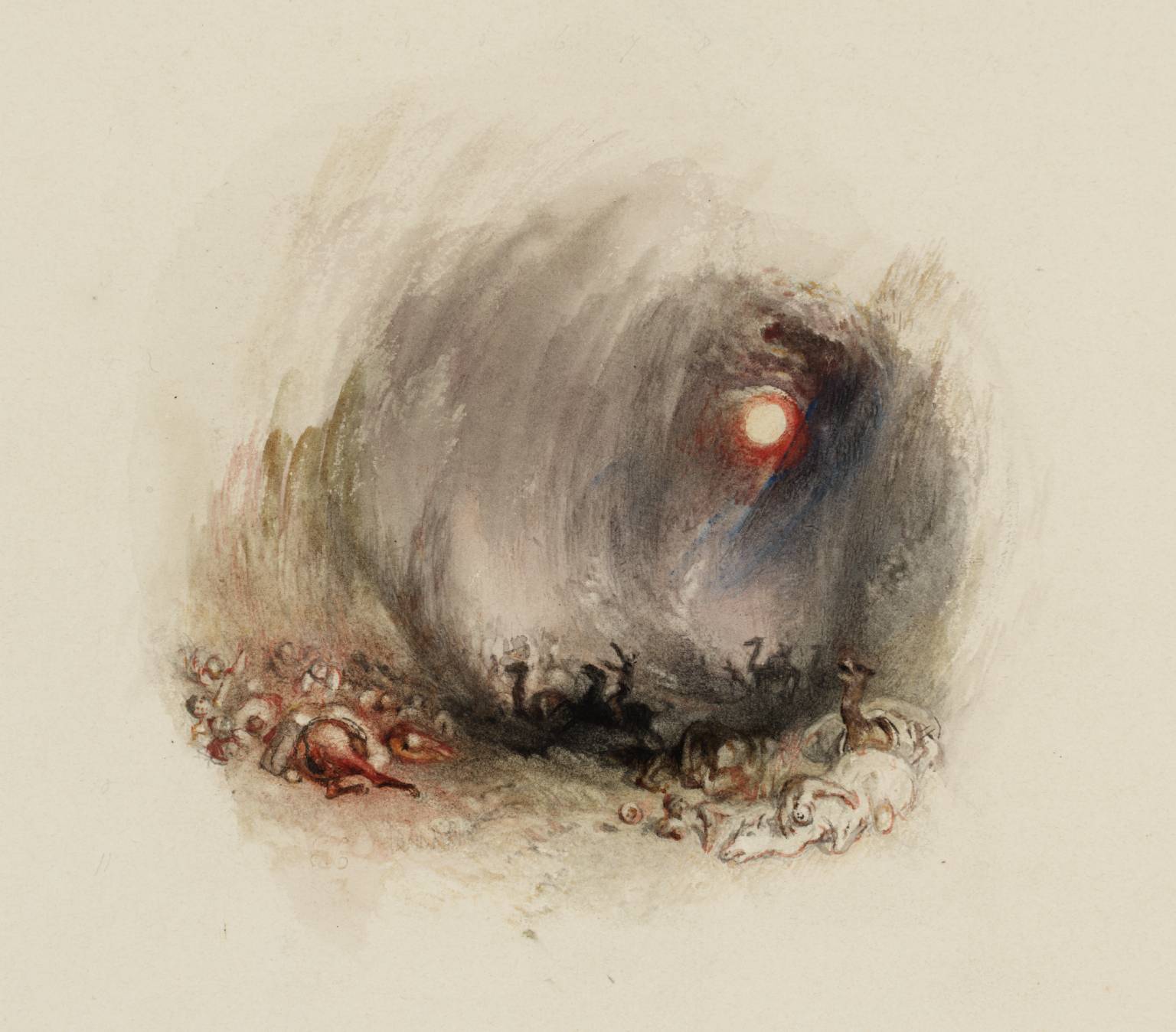
Joseph Mallord William Turner, A Hurricane in the Desert (The Simoom), for Rogers’s ‘Poems’ &²Ô²ú²õ±è;³¦.1830–2
Turner explored the theme of humanity and nature throughout his career. Here he illustrates lines from Rogers’s poem, ‘Human Life’, that describe a group of desert travellers caught up in a deadly sandstorm. The watercolour’s title contains the word ‘simoom’, which means ‘poison wind’ in Arabic. Turner had never experienced this weather but adapted elements of his earlier oil painting of a snowstorm, such as the contrast of the sun against the dark, deadly vortex and a mass of figures.
Gallery label, January 2025
29/30
artworks in Experiments on Paper
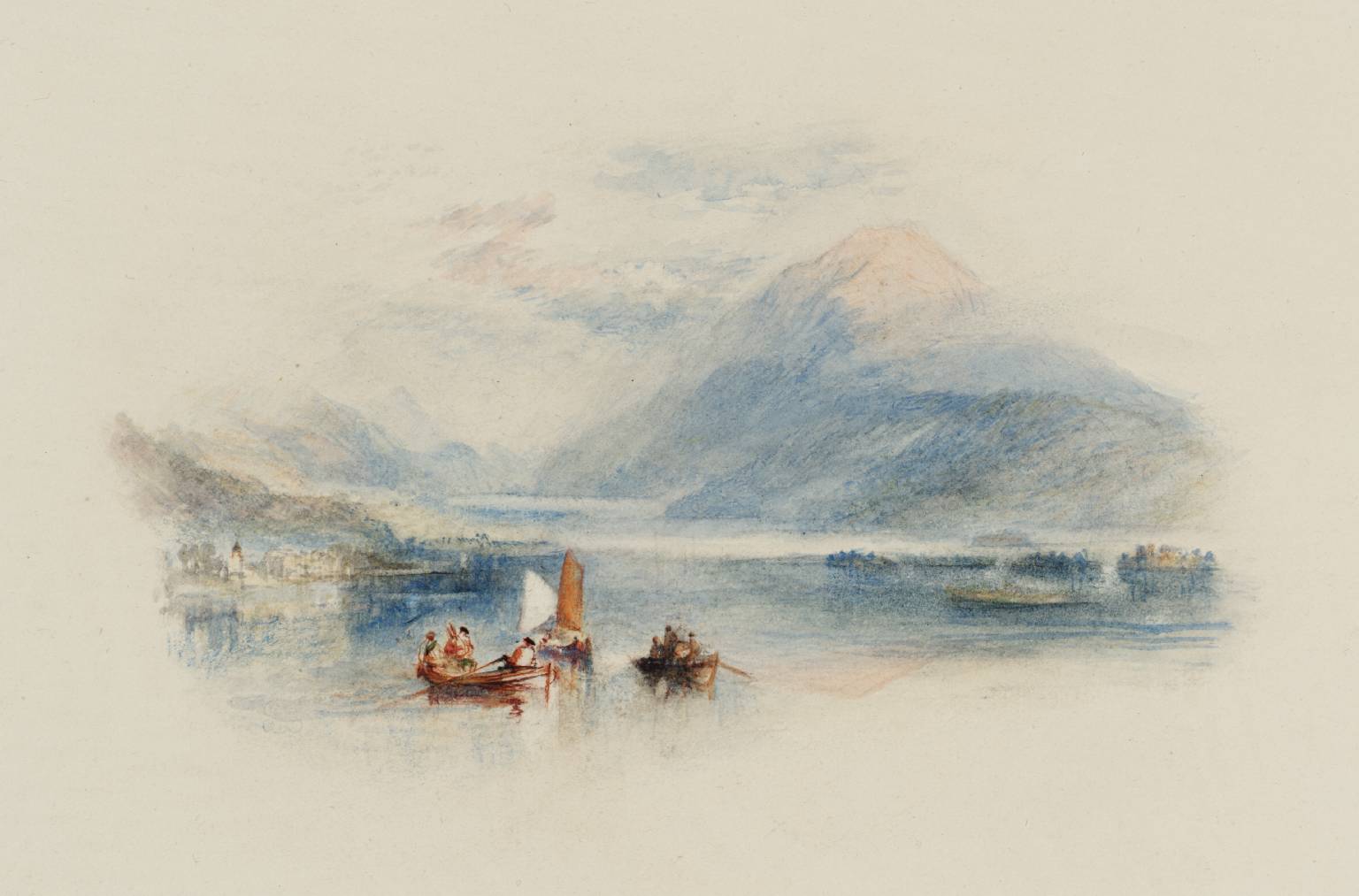
Joseph Mallord William Turner, Loch Lomond, for Rogers’s ‘Poems’ &²Ô²ú²õ±è;³¦.1830–2
This watercolour was inspired by a passage in a poem called ‘Written in the Highlands of Scotland, September 2, 1812’: ‘Blue was the loch, the clouds were gone Ben–Lomond in his glory shone’ An elevated vantage point gives us a view over boats on Loch Lomond to the mountain, Ben Lomond, rising in the distance, encircled by clouds. Figures in tartan help identify this as a Scottish scene. Like so many of Turner’s vignettes, Loch Lomond is very effective in conveying a sense of the expansiveness of the depicted landscape, despite its miniature scale.
Gallery label, January 2025
30/30
artworks in Experiments on Paper
Art in this room






























You've viewed 6/30 artworks
You've viewed 30/30 artworks
